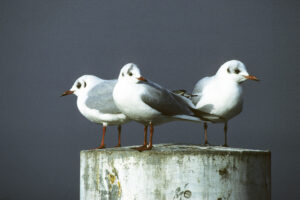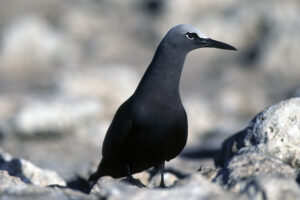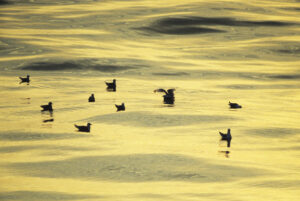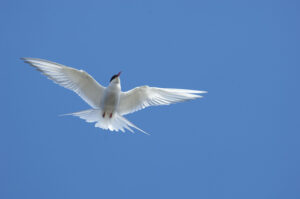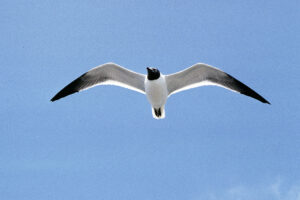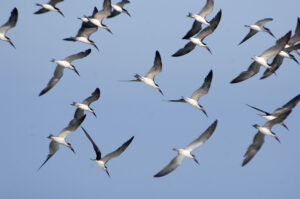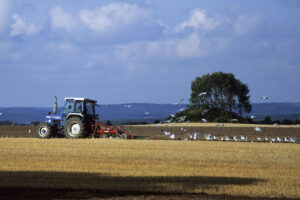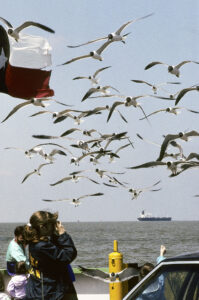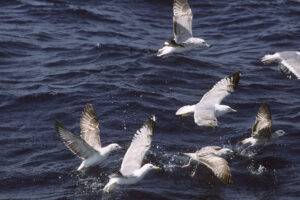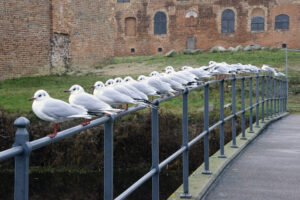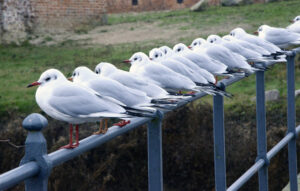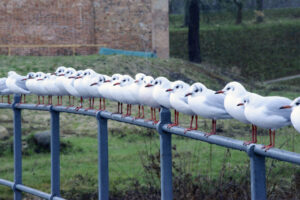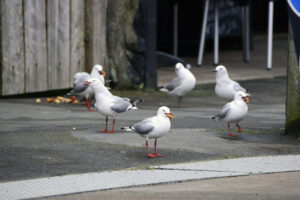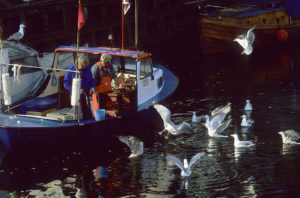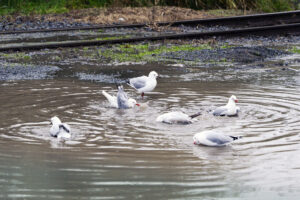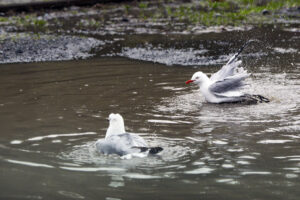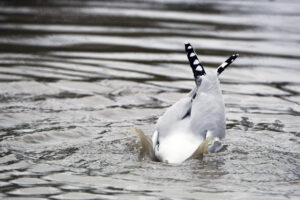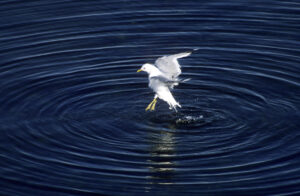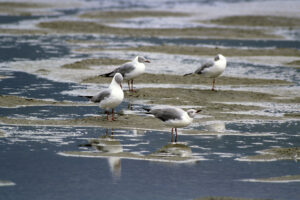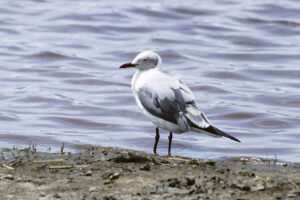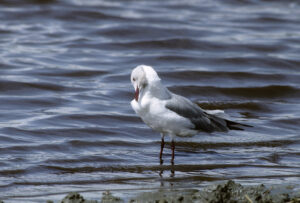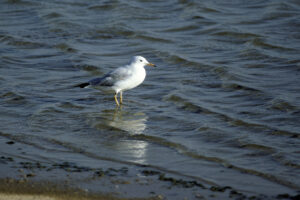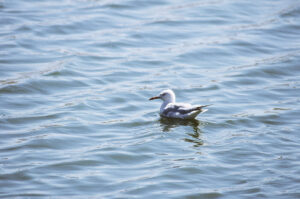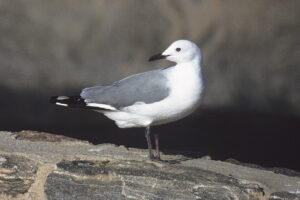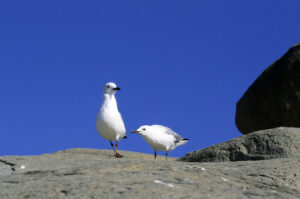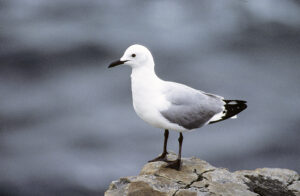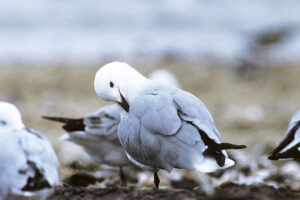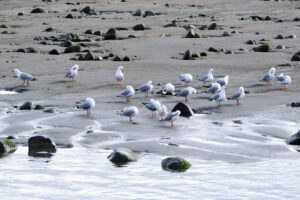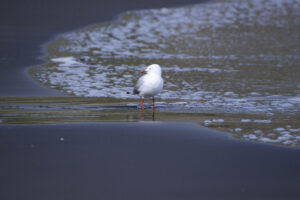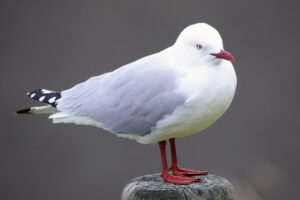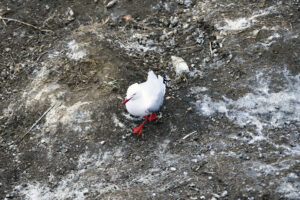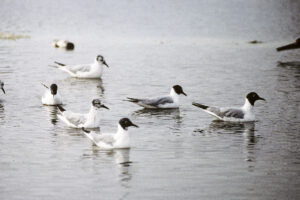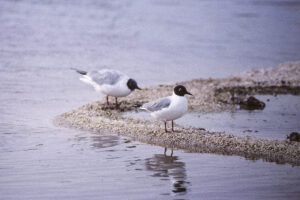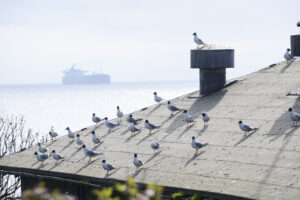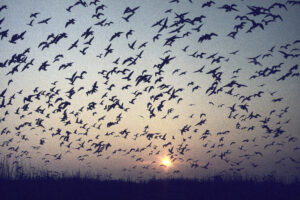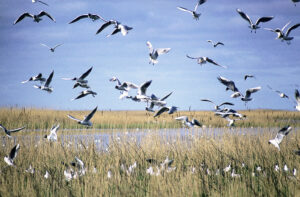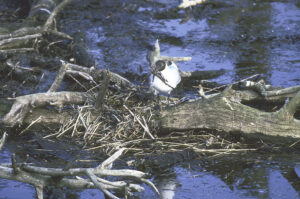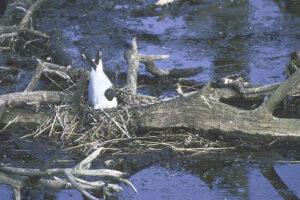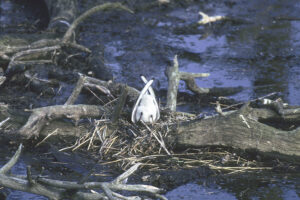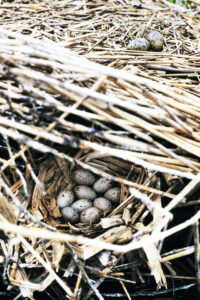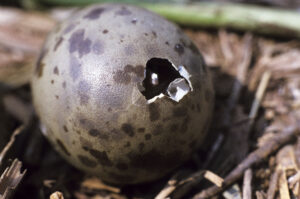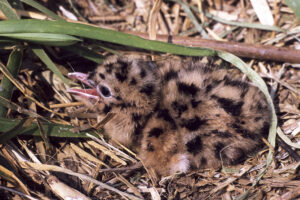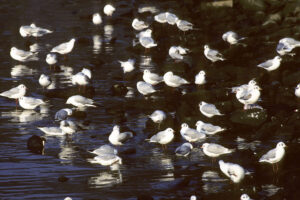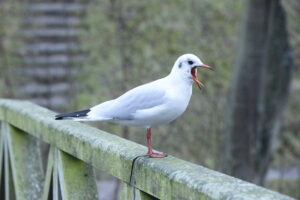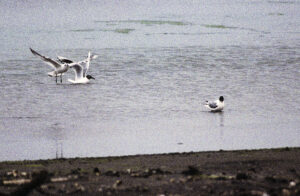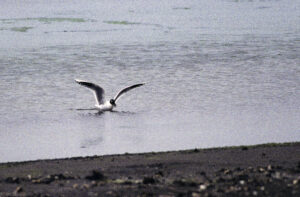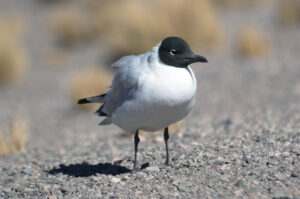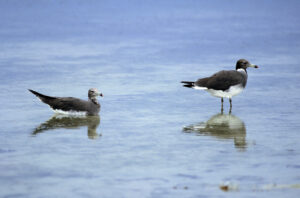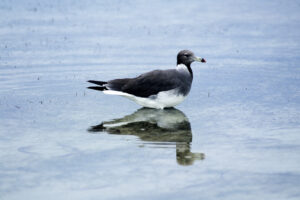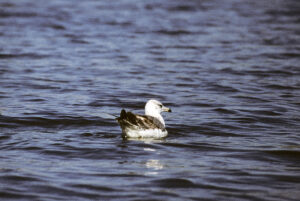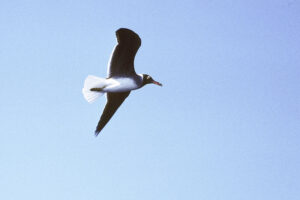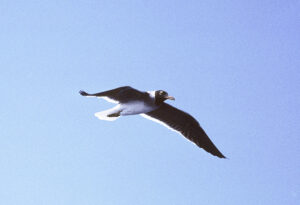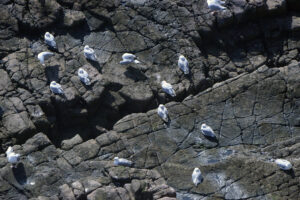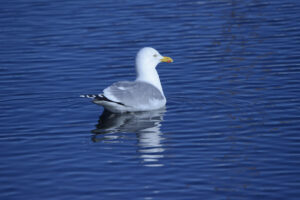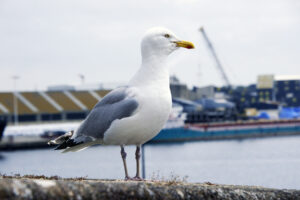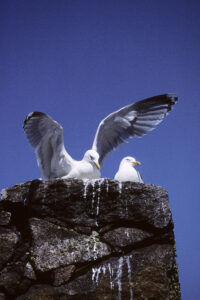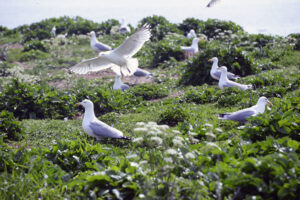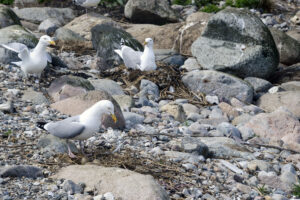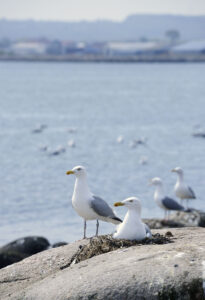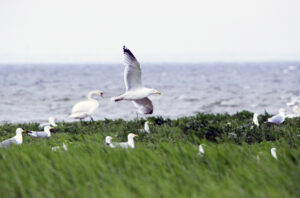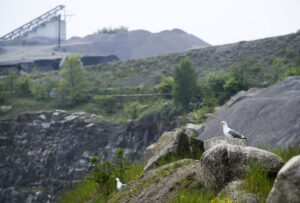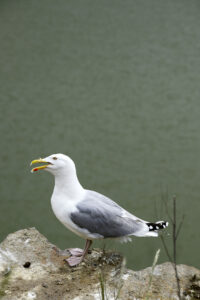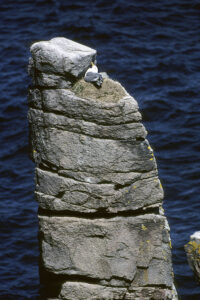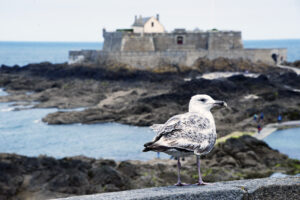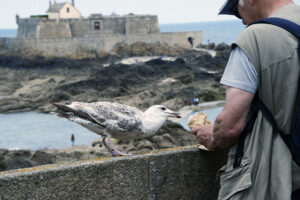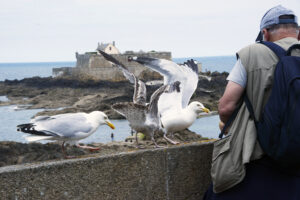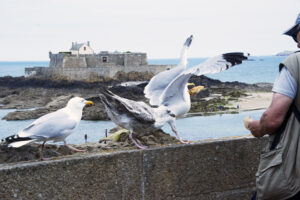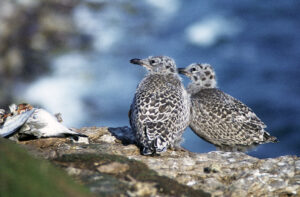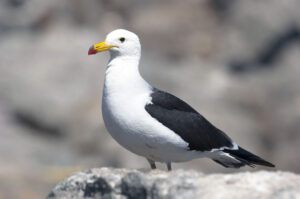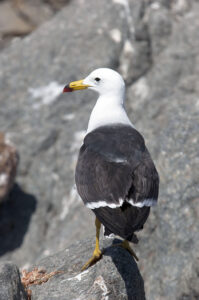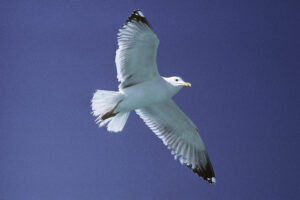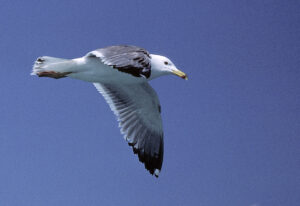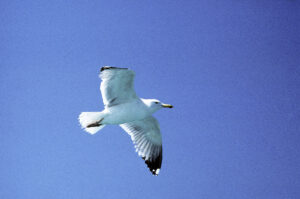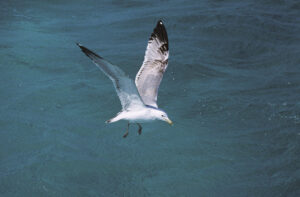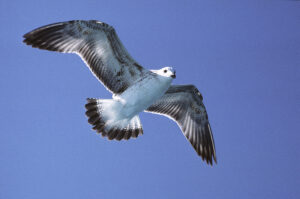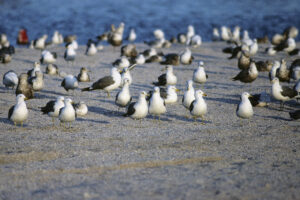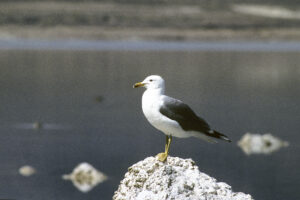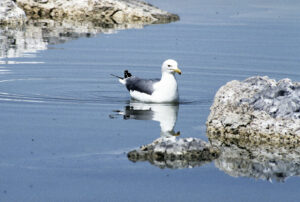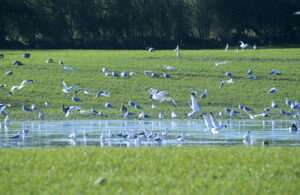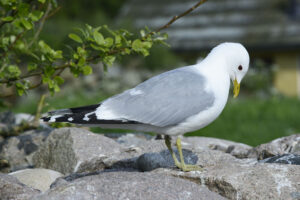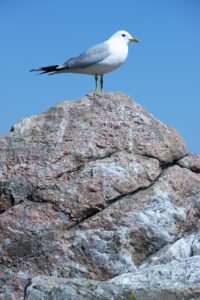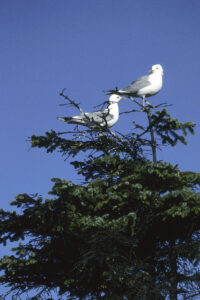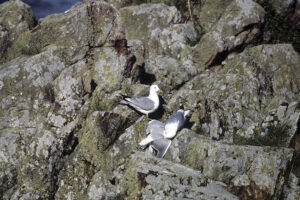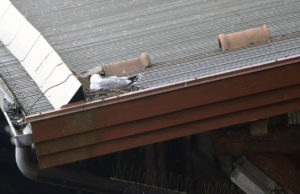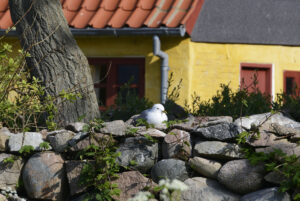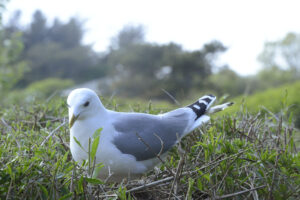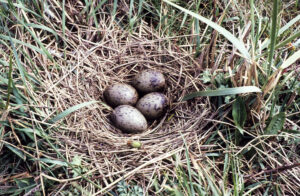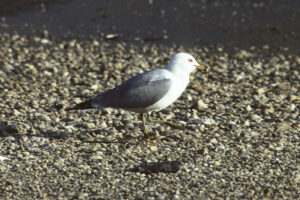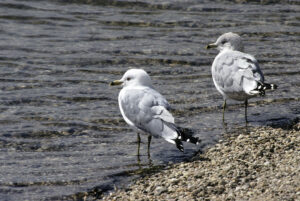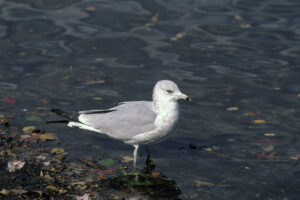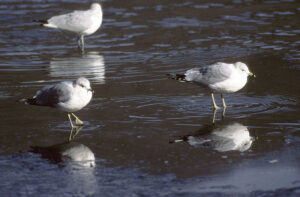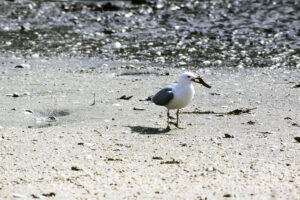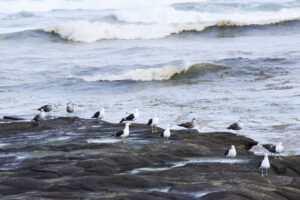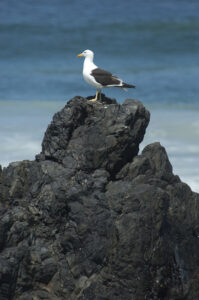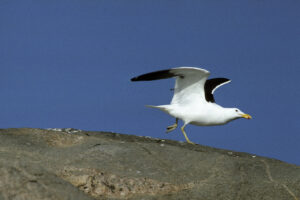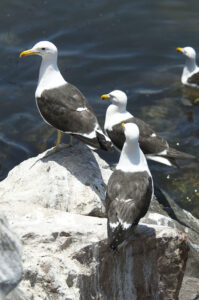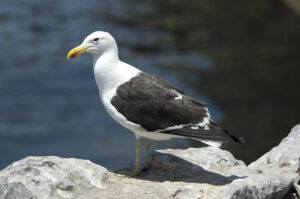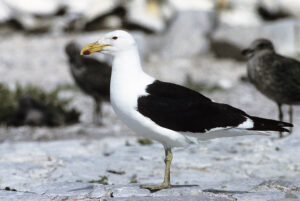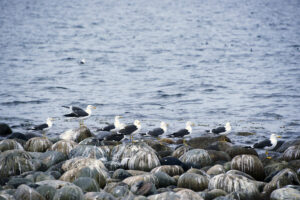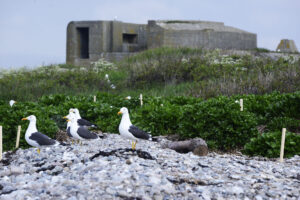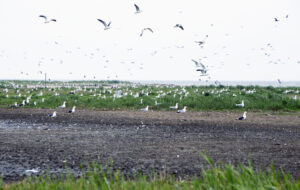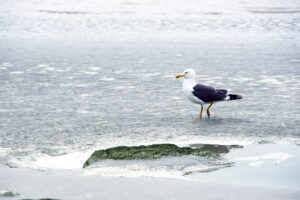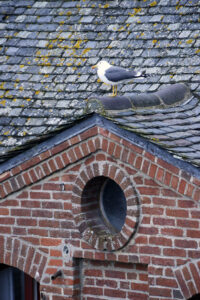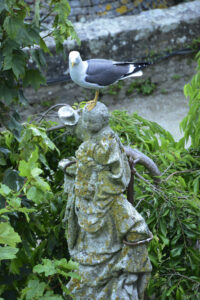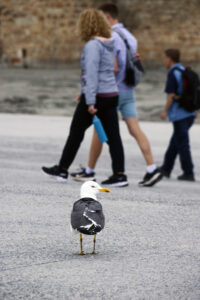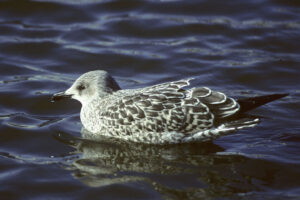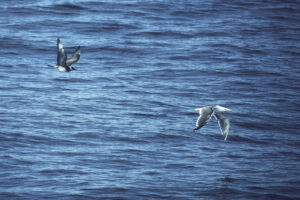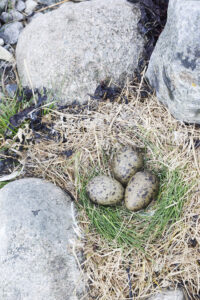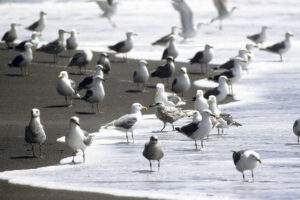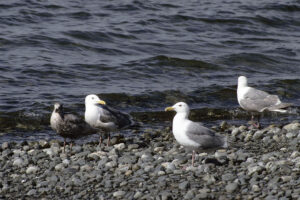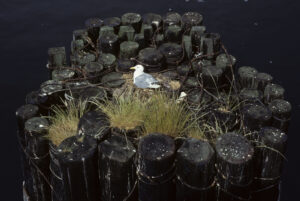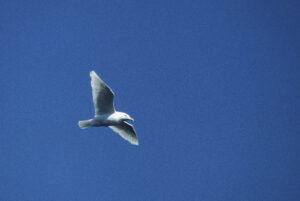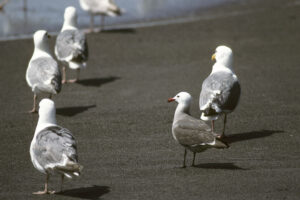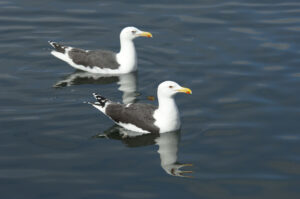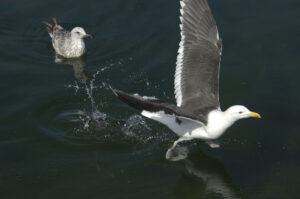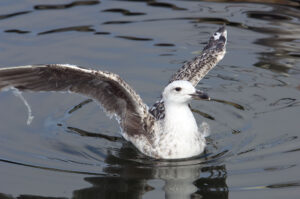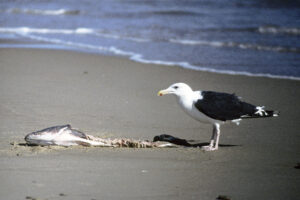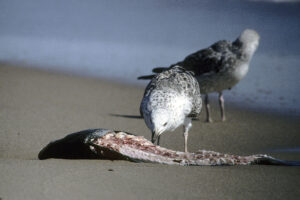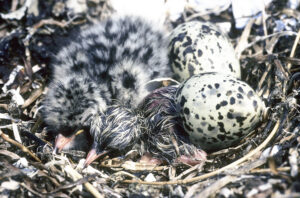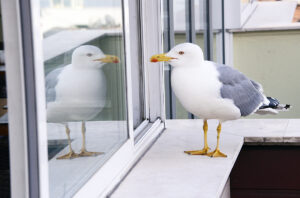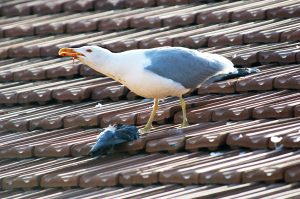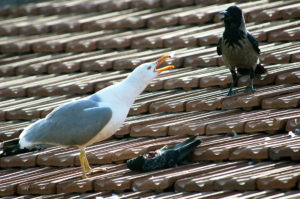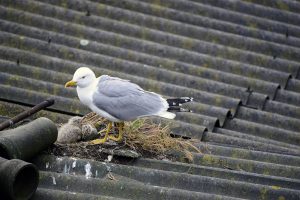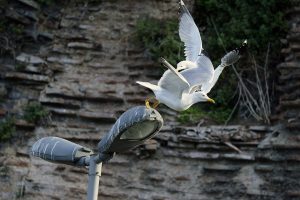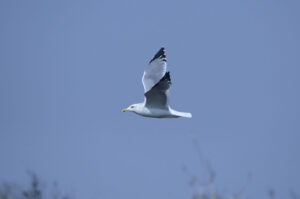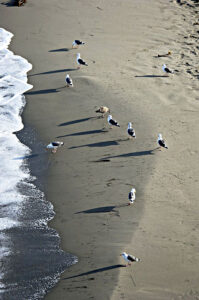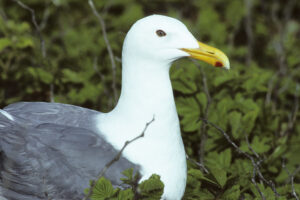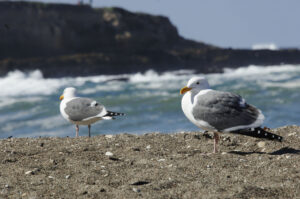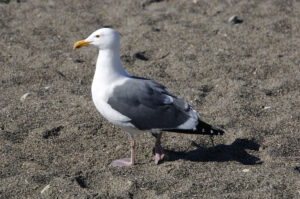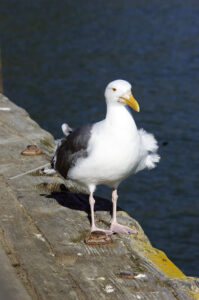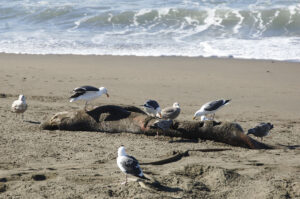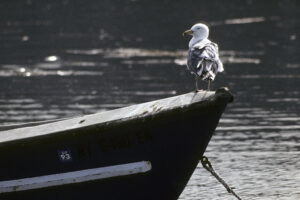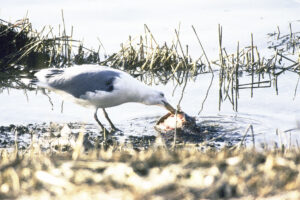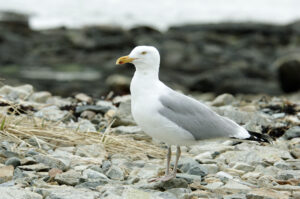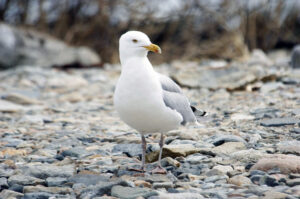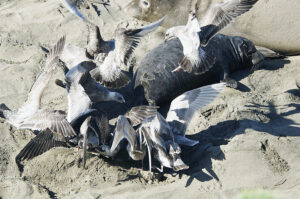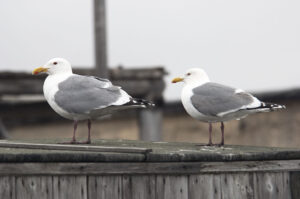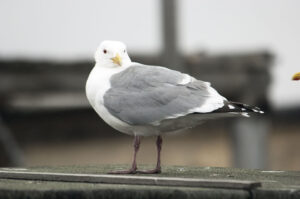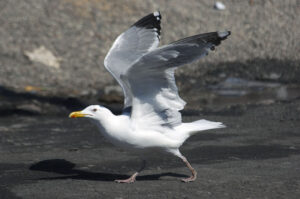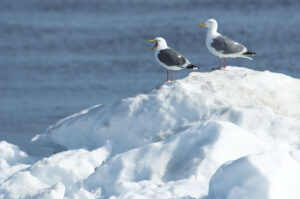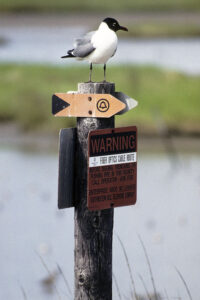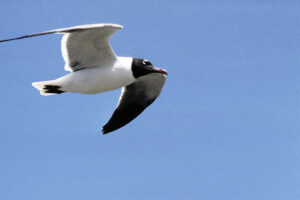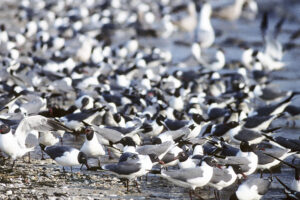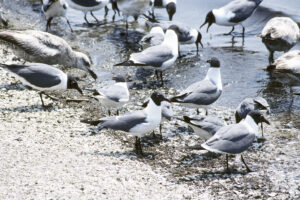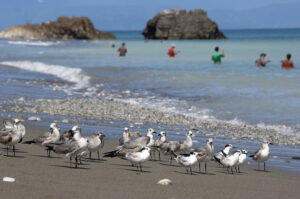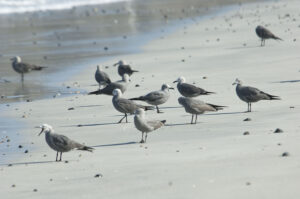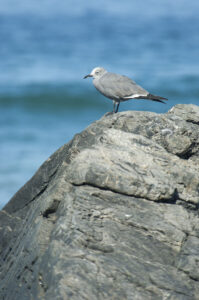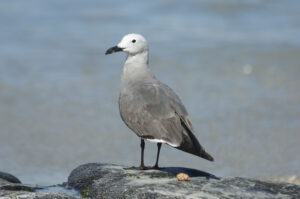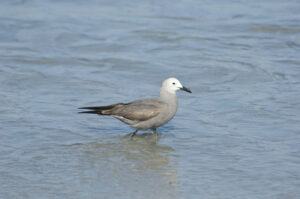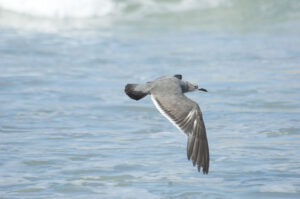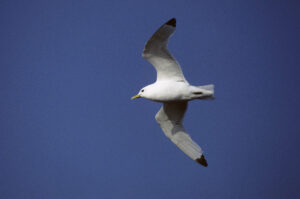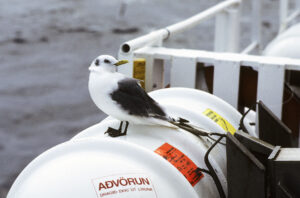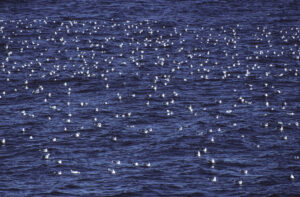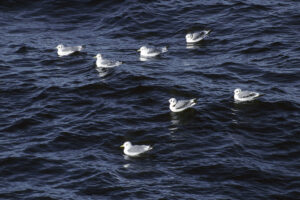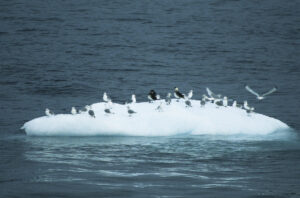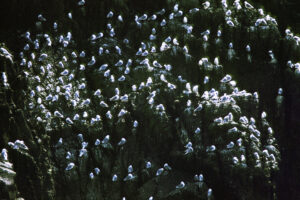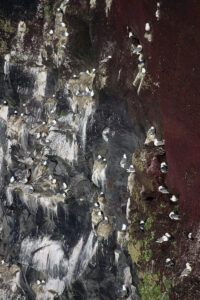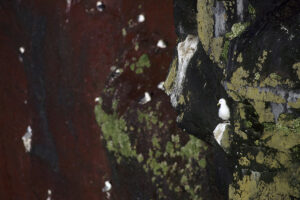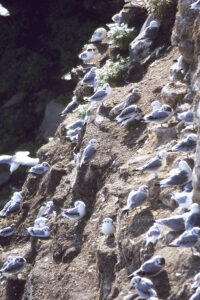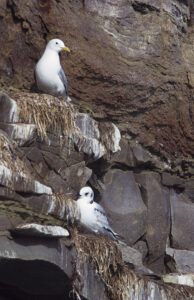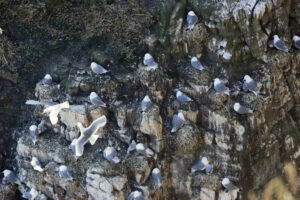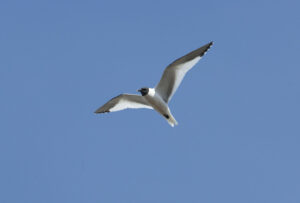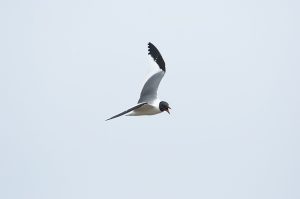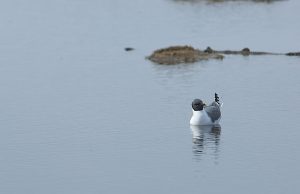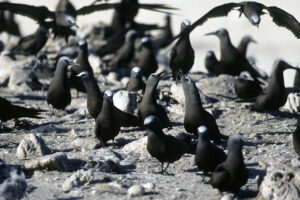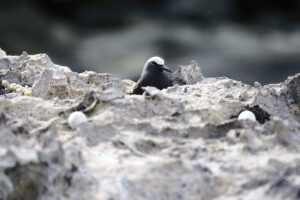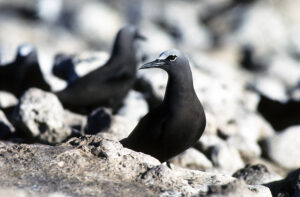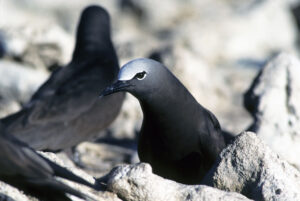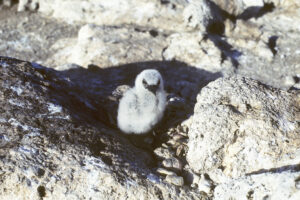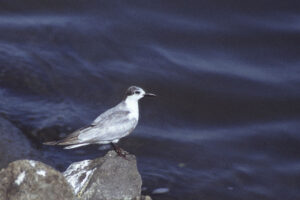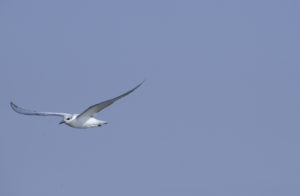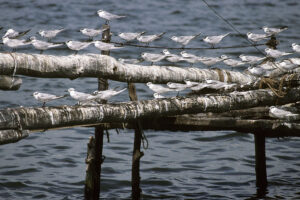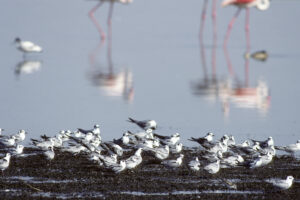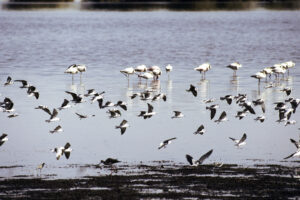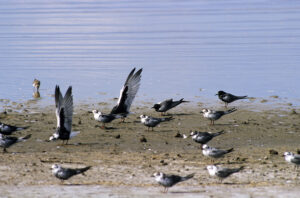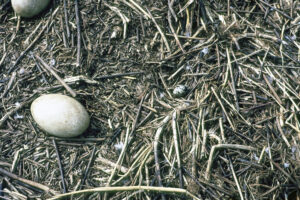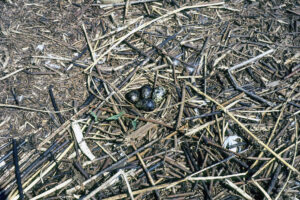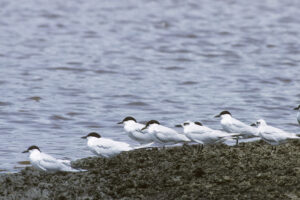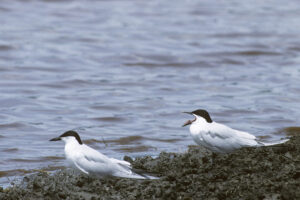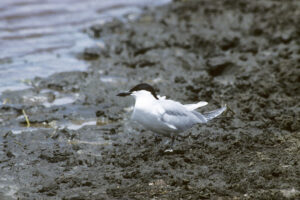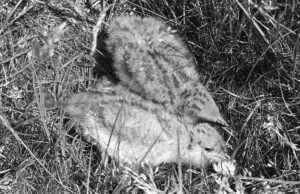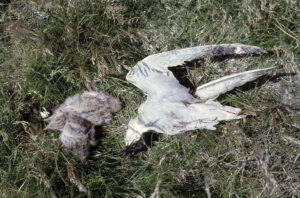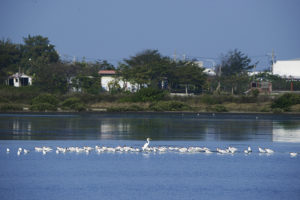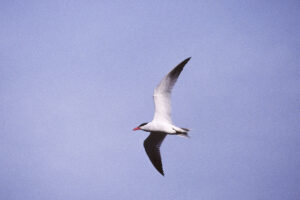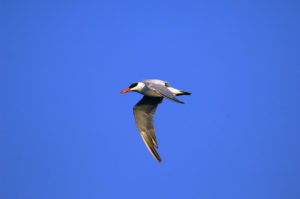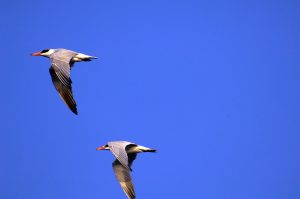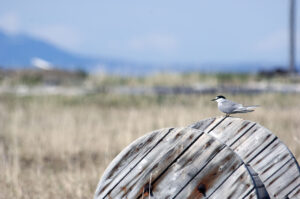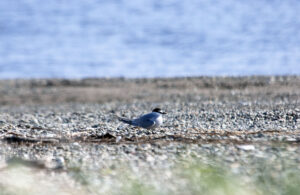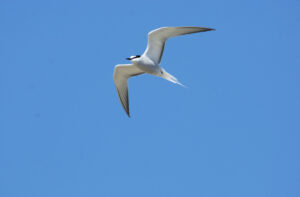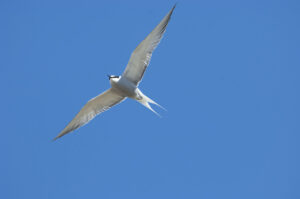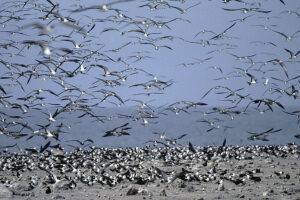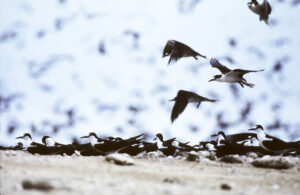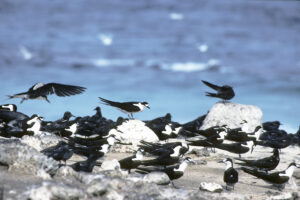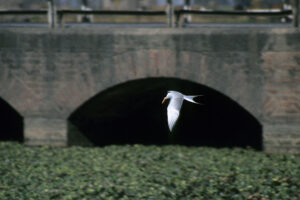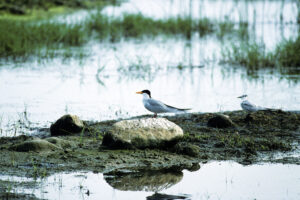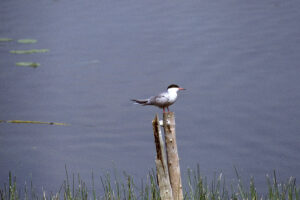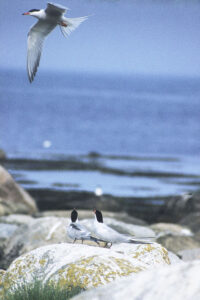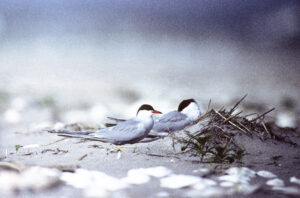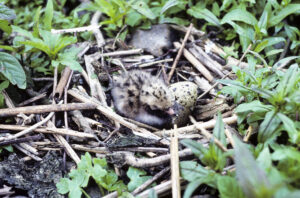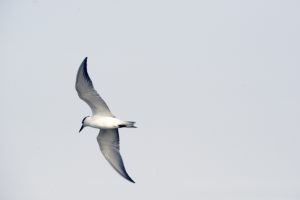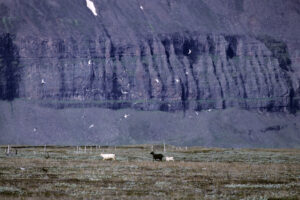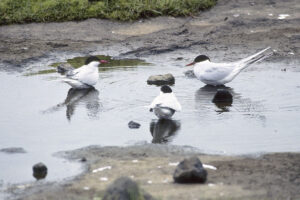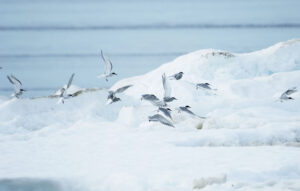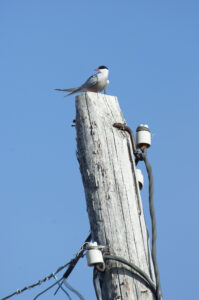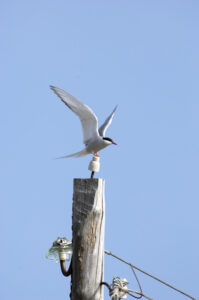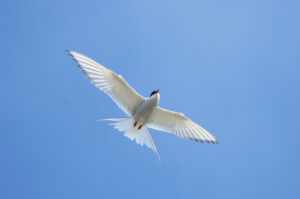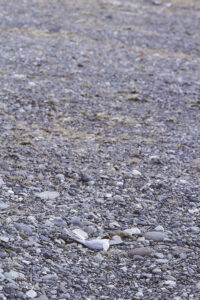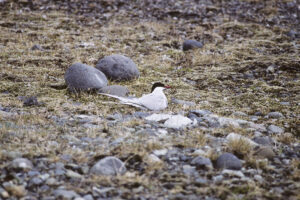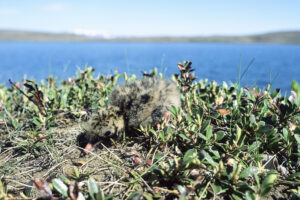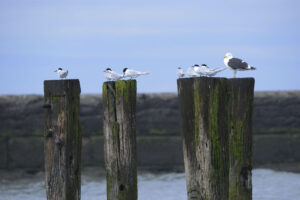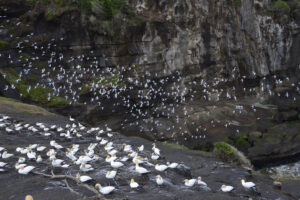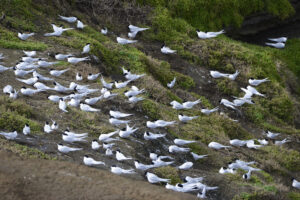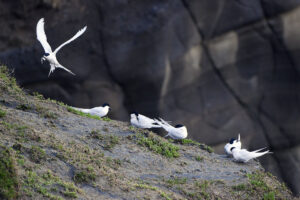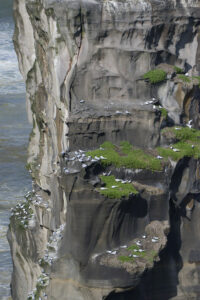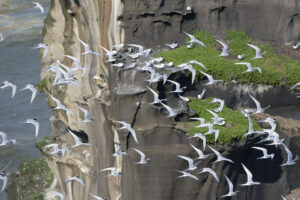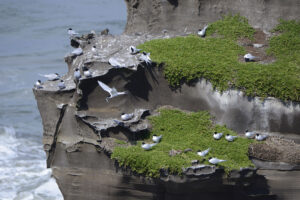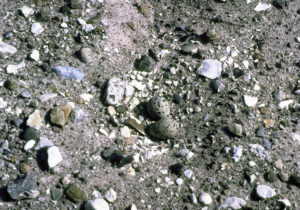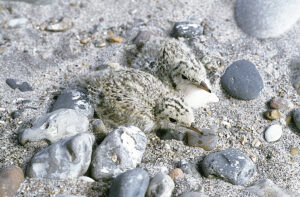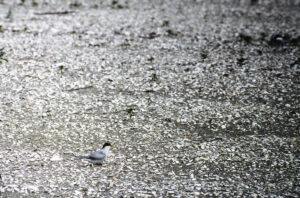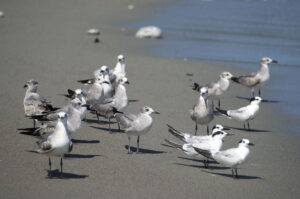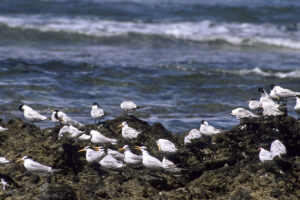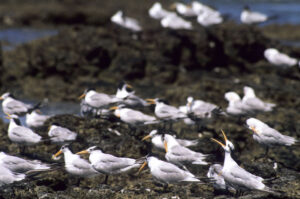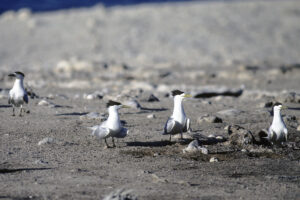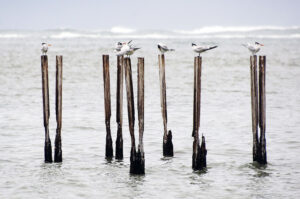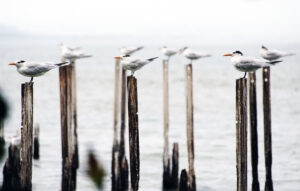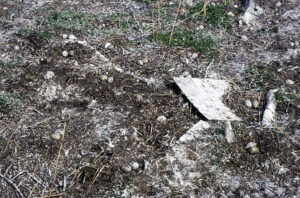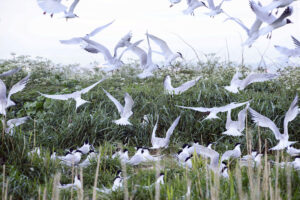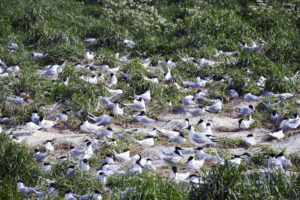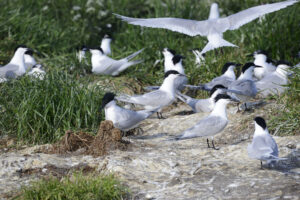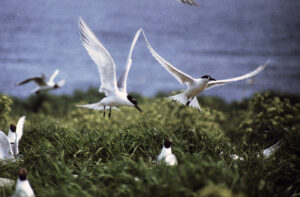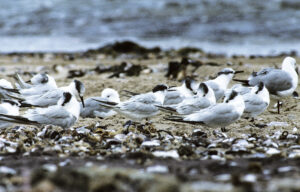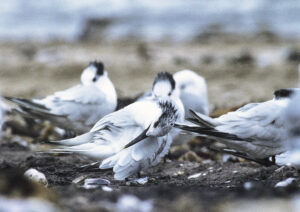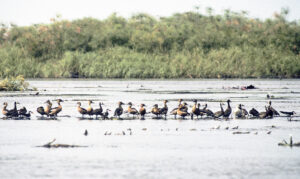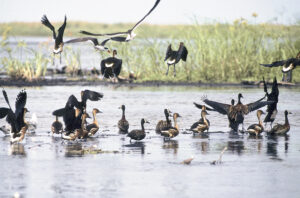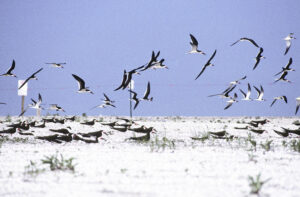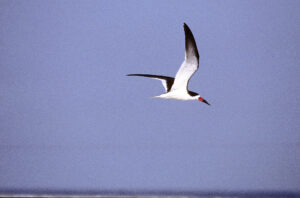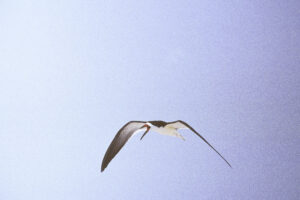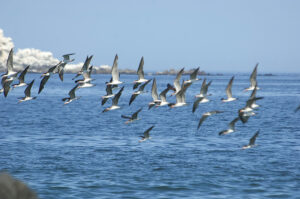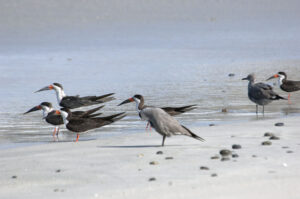Gulls, terns and skimmers
Black-headed gulls (Chroicocephalus ridibundus) in winter plumage, Bregenz, Bodensee, Austria. (Photo copyright © by Kaj Halberg)
Brown noddy (Anous stolidus), nesting on rocks of fossil coral, Latham Island, Tanzania. (Photo copyright © by Kaj Halberg)
Kittiwakes (Rissa tridactyla) in evening light, off the west coast of Greenland. (Photo copyright © by Kaj Halberg)
Arctic tern (Sterna paradisaea), Kosa Nikolaya, Chukotka, eastern Siberia. (Photo copyright © by Kaj Halberg)
Laughing gull (Leucophaeus atricilla), following a ferry, Galveston, Texas. (Photo copyright © by Kaj Halberg)
Black skimmers (Rynchops niger), Pan de Azucar National Park, Chile. (Photo copyright © by Kaj Halberg)
While the elegant terns appeal to most people, and the skimmers fascinate with their peculiar bill, many birdwatchers have a tendency to more or less ignore gulls, especially the larger ones, which, following genetic studies, have been split into an array of very similar species. Especially the young birds are hard to identify.
However, despite their raucous voices and aggressive and rapacious behaviour, I also find gulls fascinating. As a group, they are very successful, found in almost all corners of the world, from the tropics to the poles, and from sea level to high plateaus, as long as there are water bodies. This also accounts for the terns, whereas two of the three skimmer species are restricted to tropical areas.
Together, these three groups constitute the family Laridae. Of the 22 genera and about 100 species in the family, gulls comprise 10 genera and about 53 species, terns 11 genera and c. 47 species, and skimmers a single genus with 3 species.
Below, I present those members of Laridae that I have managed to photograph around the world. Within each of the three groups, the birds are presented in alphabetical order, according to genus and species.
I have probably misidentified some species, especially among the American gulls. I would be grateful to get corrections. You may use the address at the bottom of the page.
Gulls
“A remarkable method of catching gulls, derived from the Indians, was practiced in Wellfleet, in 1794. “The Gull House”, it is said, “is built with crotchets, fixed in the ground on the beach,” poles being stretched across for the top, and the sides made close with stakes and sea-weed. “The poles on the top are covered with lean whale. The man being placed within, is not discovered by the fowls, and while they are contending for and eating the flesh, he draws them in, one by one, between the poles, until he has collected forty or fifty.”
American writer Henry David Thoreau (1817-1862), in his book Cape Cod, first published 1865.
Gulls often follow ploughing tractors to snap worms, larvae, and other animals disturbed by the plough.
Common gulls (Larus canus), following a ploughing tractor, Jutland, Denmark. (Photo copyright © by Kaj Halberg)
Gulls also follow ferries to eat edible garbage thrown overboard. The passengers also often feed the birds.
Laughing gulls (Leucophaeus atricilla), following a ferry, Galveston, Texas. (Photos copyright © by Kaj Halberg)
Black-headed gull (Chroicocephalus ridibundus), following a ferry between Esbjerg and Fanø, Denmark. (Photo copyright © by Kaj Halberg)
Adult and immature Caspian gulls (Larus cachinnans), eating garbage from a ferry, Hurghada, Egypt. (Photo copyright © by Kaj Halberg)
Previously, the majority of gulls were breeding in wetlands, and they were rather shy of people. During the last 50 years, however, many species have readily adapted to a life in cities, feeding mainly on garbage and often breeding on house roofs.
Black-headed gulls (Chroicocephalus ridibundus) in winter plumage, resting on the rail of a foot bridge across the moat of Nyborg Castle, Funen, Denmark. They lined up, when I approached the bridge, so presumably people had been feeding them regularly. (Photos copyright © by Kaj Halberg)
Red-billed gulls (Chroicocephalus novaehollandiae ssp. scopulinus), eating bread, Maungaturoto, New Zealand. (Photo copyright © by Kaj Halberg)
Herring gulls (Larus argentatus), eating offal from a fishing vessel, Copenhagen, Denmark. (Photo copyright © by Kaj Halberg)
Many gulls live along the coast, but like to bathe in freshwater.
Red-billed gulls (Chroicocephalus novaehollandiae ssp. scopulinus), bathing in a freshwater pool, Kawakawa, New Zealand. (Photos copyright © by Kaj Halberg)
Common gull (Larus canus), taking off after bathing in a freshwater pool, Christiansø, Bornholm, Denmark. (Photo copyright © by Kaj Halberg)
Chroicocephalus
This genus with 11 species of small to medium-sized gulls is found almost worldwide. Until recently, they were included in the genus Larus.
The generic name is derived from Ancient Greek khroizo (‘to colour’) and kephale (‘head’), alluding to the dark head of many of the species in the breeding season.
Chroicocephalus cirrocephalus Grey-headed gull
This bird is widely distributed along coasts, rivers, and lakes in sub-Saharan Africa, Madagascar, and south-eastern and north-western South America. It is largely sedentary, but may stray far outside the breeding season.
The specific name is derived from the Latin cirrhus (‘grey’), and Ancient Greek kephale (‘head’). The Latin part is modified, as it originally stemmed from Ancient Greek kirrhos (‘tawny’).
Grey-headed gulls, Ngorongoro Crater, Tanzania. In the upper picture, one bird shows a threatening attitude. (Photos copyright © by Kaj Halberg)
Chroicocephalus genei Slender-billed gull
A rare gull, breeding locally around the Mediterranean, in Mauritania, around the Black Sea and the Caspian Sea, and from the Near East eastwards to Kazakhstan, Afghanistan, and north-western India.
The specific name commemorates Italian naturalist Giuseppe Gené (1800-1847), professor of zoology and director of the Royal Zoological Museum at Turin.
Slender-billed gulls in winter plumage, Thyna, Tunisia (top), and Ras Muhammad, Sinai, Egypt. (Photos copyright © by Kaj Halberg)
Chroicocephalus hartlaubii Hartlaub’s gull
This small gull is endemic to the coastline of South Africa and Namibia. Although a coastal species, it rarely ventures far from land. The total population is estimated at about 30,000 birds.
The specific and common names commemorate German physician and ornithologist Karel Johan Gustav Hartlaub (1814-1900), one of the founders of Journal für Ornithologie, in 1852.
Hartlaub’s gulls, Lüderitz, Namibia. (Photos copyright © by Kaj Halberg)
Hartlaub’s gulls, Lüderitz. The bird to the right assumes a threatening posture. (Photo copyright © by Kaj Halberg)
Hartlaub’s gull, Hermanus, South Africa. (Photo copyright © by Kaj Halberg)
Preening Hartlaub’s gull, Swakopmund, Namibia. (Photo copyright © by Kaj Halberg)
Chroicocephalus novaehollandiae ssp. scopulinus Red-billed gull
The red-billed gull is common throughout New Zealand. It was previously regarded as a separate species, but is now generally treated as a subspecies of the silver gull (C. novaehollandiae) of Australia.
The specific name means ‘New Holland’, which was the old term for Australia. The subspecific name may be derived from Ancient Greek skopelos (‘promontory’).
Red-billed gulls, preening, Waiwhakaiho River, New Plymouth, New Zealand. (Photo copyright © by Kaj Halberg)
Red-billed gulls, Muriwai Beach, New Zealand. (Photos copyright © by Kaj Halberg)
Red-billed gull in a colony of Australian gannet (Morus serrator), Muriwai Beach. (Photo copyright © by Kaj Halberg)
Chroicocephalus philadelphia Bonaparte’s gull
This small gull breeds in the major part of North America, from southern Alaska and central Canada southwards to the Mexican border and northern Georgia, wintering from southern Canada southwards to northern Mexico and Cuba.
The common name honours French ornithologist Charles Lucien Bonaparte (1803-1857), 2nd Prince of Canino and Musignano, who spent four years in the United States, updating Alexander Wilson’s Ornithology or History of the Birds of the United States.
Bonaparte’s gulls, Salton Sea, California. Most of the birds are in summer plumage, a few in transition plumage. (Photos copyright © by Kaj Halberg)
Chroicocephalus ridibundus Black-headed gull
This small gull breeds from southern Greenland and Iceland across most of Europe and temperate areas of Asia eastwards to Kamchatka, Russian Ussuriland, and north-eastern China. It is also a rare breeding bird in north-eastern North America. It winters in Europe, northern Africa, the Middle East, the Indian Subcontinent, Southeast and East Asia, Japan, and along the east coast of North America.
In former days, this species was very common in most of Europe, but it has declined drastically during the last 30 to 40 years. It does not breed on house roofs, but often on artificial islands in ponds in city parks.
The specific name is from the Latin ridere (‘to laugh’), referring to one of its calls, ke-ke-ke, mostly heard in the breeding colonies. Despite its common name, the head (in the breeding plumage) is not black, but a dark chocolate brown.
Black-headed gulls in breeding plumage, resting on a roof, Hirsholmene, Denmark. (Photo copyright © by Kaj Halberg)
Large colony of black-headed gulls at sunset, Hirsholmene. (Photo copyright © by Kaj Halberg)
Colony of black-headed gulls, Ringkøbing Fjord, Denmark. (Photo copyright © by Kaj Halberg)
Black-headed gull, bringing nesting material to its nest, which is placed on a toppled tree in a pond, Nature Reserve Vorsø, Horsens Fjord, Denmark. In the two lower pictures, it uses its legs to form the nest. (Photos copyright © by Kaj Halberg)
In this picture, a black-headed gull has placed its nest on reeds above a nest of moorhen (Gallinula chloropus), Lake Brabrand, Jutland, Denmark. (Photo copyright © by Kaj Halberg)
Hatching chick of black-headed gull, Lake Brabrand. The egg-tooth is clearly visible. (Photo copyright © by Kaj Halberg)
Newly hatched chick of black-headed gull, Lake Brabrand. (Photo copyright © by Kaj Halberg)
Evening light on black-headed gulls in winter plumage, with a single coot (Fulica atra), Bregenz, Bodensee, Austria. (Photo copyright © by Kaj Halberg)
Adult black-headed gull in winter plumage, resting on the rail of a foot bridge across the moat of Nyborg Castle, Denmark. (Photo copyright © by Kaj Halberg)
Chroicocephalus saundersi Saunders’s gull
This very small gull, also known as Chinese black-headed gull, is a coastal species, found from Russian Ussuriland southwards through eastern China, Korea, and Japan to Taiwan and Vietnam. Some authorities claim that it is sufficiently distinct to be placed in a separate genus, Saundersilarus.
It was named for British businessman and ornithologist Howard Saunders (1835-1907).
Saunders’s gulls, Cigu Wetlands, Tainan, Taiwan. (Photos copyright © by Kaj Halberg)
Chroicocephalus serranus Andean gull
This medium-sized gull, breeding in the Andes of Chile, Argentina, Bolivia, Ecuador, Peru, and Colombia, lives along rivers and in lakes, saline marshes, and pastureland.
The specific name is derived from the Portuguese serra (‘mountain range’).
Andean gull, Miscanti and Miniques Lakes, Atacama, Chile. (Photo copyright © by Kaj Halberg)
Ichthyaetus
A genus of 6 gulls, found from Europe, north-eastern Africa, and the Middle East eastwards across Central Asia to north-eastern China. They were formerly placed in the genus Larus.
The generic name stems from German naturalist and explorer Peter Simon Pallas (1741-1811). During his travels in Siberia and Kyrgyzstan in 1773, he collected a large gull, naming it Larus ichthyaetus, the specific name derived from Ancient Greek ikhthys (‘fish’) and aetos (‘eagle’). Thus, loosely translated, the name means ‘the gull that resembles a fish-eagle’, presumably alluding to its large size. Today, this gull is named Ichthyaetus ichthyaetus (see below).
Thus the generic name means ‘fish-eagle’ – a very unfortunate name for a group of gulls!
Ichthyaetus hemprichii Sooty gull
This distinctive gull is native from the Red Sea, the Gulf of Aden, and the Persian Gulf eastwards to Pakistan, and along the eastern African coast as far south as Tanzania.
The specific name was given in honour of German naturalist and explorer Wilhelm Friedrich Hemprich (1796-1825), who travelled extensively in Egypt, Sudan, and Ethiopia. He died of malaria in Ethiopia, only 29 years old.
Sooty gulls, adult (right) and immature, Kunduchi Beach, Dar es Salaam, Tanzania. The bottom picture shows the adult bird. (Photos copyright © by Kaj Halberg)
Ichthyaetus ichthyaetus Great black-headed gull, Pallas’s gull
This large species breeds in marshes and lakes, from Crimea eastwards across Kazakhstan to Mongolia and northern China (Gansu, Qinghai, and Inner Mongolia). It is migratory, wintering in the eastern Mediterranean, north-eastern Africa, Arabia, Iran, Pakistan, and India.
As explained above under the genus name, Pallas originally named this gull Larus ichthyaetus, which loosely translates as ‘the gull that resembles a fish-eagle’. However, after being placed in this genus, its name means ‘fish-eagle – fish-eagle’ – a ridiculous name for a gull!
A large flock of great black-headed gulls, resting on a large sand bar in the Maipura River delta, Bhitarkanika Wildlife Reserve, Odisha, India. (Photo copyright © by Kaj Halberg)
Immature great black-headed gull, Lake Tana, Ethiopia. (Photo copyright © by Kaj Halberg)
Ichthyaetus leucophthalmus White-eyed gull
This striking bird is largely confined to the Red Sea, although it has also been observed in the Persian Gulf and the eastern part of the Mediterranean. The world population has been estimated at 4,000-6,000 pairs.
The specific name is derived from Ancient Greek leukos (‘white’) and ophthalmos (‘eye’), referring to the white spots above and below the eye.
White-eyed gull, Hurghada, Egypt. (Photos copyright © by Kaj Halberg)
Larus
Formerly, most gulls were placed in this genus, but genetic research has lead to the resurrection of the genera Ichthyaetus, Chroicocephalus, Leucophaeus, and Hydrocoloeus. The systematics of the larger species is very complicated, and a number of former subspecies have recently been elevated to separate species. Today, according to the IOC World Bird List (worldbirdnames.org), the genus contains 24 species.
The generic name is a Latinized form of Ancient Greek laros, pertaining to a kind of ravenous sea bird, presumably a gull.
Larus argentatus Herring gull
Previously, the herring gull was regarded as being a circumpolar species, divided into a number of subspecies. Today, however, it has been split into several species, and the herring gull proper is restricted to north-western Europe, from Iceland, northern Norway, and north-western Russia southwards along the coasts of the Baltic Sea, Denmark, the British Isles as far west as Ireland, and along the Atlantic coast southwards to southern France. The major part of the Russian, Finnish, and Swedish birds are migratory, spending the winter as far south as the Portuguese Atlantic coast.
In later years, numbers of European herring gulls have increased significantly in cities, where the birds place their nest on top of high-rise buildings.
The specific name is derived from the Latin argentum (‘silver’) and the suffix atus (‘resembling’), thus ‘silvery’, presumably alluding to its pale grey wings.
Resting herring gulls, Cap Frehel, Brittany. (Photo copyright © by Kaj Halberg)
Herring gull, Nyborg Harbour, Denmark (top), and St. Malo, Brittany. (Photos copyright © by Kaj Halberg)
Herring gulls, resting on a wall, Christiansø, Bornholm, Denmark. Judging from the amount of dung, it is often frequented by the gulls. (Photo copyright © by Kaj Halberg)
Koloni af sølvmåge på øen Deget nær Frederikshavn. (Fotos copyright © by Kaj Halberg)
Mixed breeding colony of herring gull and lesser black-backed gull (L. fuscus, below) on the island Klægbanken, Ringkøbing Fjord, Denmark. A mute swan (Cygnus olor) is also present. (Photo copyright © by Kaj Halberg)
Herring gulls, breeding on steep rocks surrounding a quarry near Rønne, Bornholm, Denmark. In the lower picture, the bird emits its warning call, when I approach too close to its nest. (Photo copyright © by Kaj Halberg)
This herring gull has placed its nest on top of Lyseklippen (‘Candle Rock’), a 22 m high, columnar rock at Helligdomsklipperne, Bornholm, Denmark. (Photo copyright © by Kaj Halberg)
This man was feeding a young herring gull with bread, but adult birds were of the opinion that the bread belonged to them. – St. Malo, Brittany. (Photos copyright © by Kaj Halberg)
Herring gull chicks, Ekkerøy, Varanger Peninsula, Norway. Remains of their food, a young black-legged kittiwake (Rissa tridactyla), is seen to the left. (Photo copyright © by Kaj Halberg)
Larus belcheri Band-tailed gull
This species is restricted to a rather small area on the Pacific coast, from northern Peru southwards to northern Chile, living on rocky shores and offshore islands. It is quite similar to the widespread kelp gull (below), but in flight it may be identified by the broad black tail band with a white trailing edge, and at close quarters by the distinctive red and black tip of the bill.
The specific name was applied in honour of British naval officer, hydrographer, and explorer Sir Edward Belcher (1799-1877) who performed survey work on the Pacific coast of South America.
Band-tailed gull, Pan de Azucar National Park. (Photos copyright © by Kaj Halberg)
Larus cachinnans Caspian gull
This gull breeds from eastern Europe across the plains to Kazakhstan and north-western Xinjiang, spending the winter months in northern and eastern Europe, around the Black and Caspian Seas, in Iran, and from the Red Sea along the southern coast of the Arabian Peninsula to Pakistan.
The specific name is derived from the Latin cachinnare (‘to laugh aloud’).
Caspian gulls, adult (upper two), subadult (next two), and immature, Hurghada, Red Sea, Egypt. (Photos copyright © by Kaj Halberg)
Larus californicus California gull
This medium-sized gull breeds in central Canada eastwards to Manitoba, southwards to the Dakotas and Colorado, and thence westwards to Washington, Oregon, northern California, and northern Nevada. It mainly winters along the Pacific coast, from Vancouver southwards to central Mexico.
California gulls in evening light, Salton Sea, California. (Photos copyright © by Kaj Halberg)
California gull, Lake Mono, California. (Photo copyright © by Kaj Halberg)
California gull, feeding on alkali flies (Ephydra hians), Lake Mono. (Photo copyright © by Kaj Halberg)
Larus canus Common gull
This species has a very wide distribution, from Ireland and Scotland eastwards through the Siberian taiga belt to Alaska and western Canada. It mostly breeds on the ground in coastal regions and lakes, but may occasionally build its nest on roofs or in trees. It resembles the herring gull, but is smaller and has a narrow red eye-ring, and a greenish-yellow bill without a red dot. The European and Russian subspecies also have dark eyes.
The specific name is Latin, meaning ‘white’, originally from Proto-Italian kaznos (‘pale grey’).
Common gulls, herring gulls (Larus argentatus), and greylag geese (Anser anser), resting in a flooded field, eastern Funen, Denmark. (Photo copyright © by Kaj Halberg)
Common gull on a stone fence, Hirsholmene, Denmark. (Photo copyright © by Kaj Halberg)
Common gull, perched on a rock, Bølshavn, Bornholm, Denmark. (Photo copyright © by Kaj Halberg)
Common gulls are sometimes perched on trees. This picture is from the islet of Christiansø, Bornholm, Denmark. (Photo copyright © by Kaj Halberg)
Common gulls, locked in combat, fighting for nesting territory among coastal rocks, Melsted, Bornholm, Denmark. (Photo copyright © by Kaj Halberg)
A pair of common gulls have established their nest on a building at Alvesta Railway Station, Kronobergs Län, Sweden. (Photo copyright © by Kaj Halberg)
These common gulls have placed their nests on stone fences, Hirsholmene, Denmark. (Photos copyright © by Kaj Halberg)
Nest of common gull, Søby Rev, Jutland, Denmark. Usually, common gulls lay only three eggs, so maybe two females are involved in this case. (Photo copyright © by Kaj Halberg)
Larus delawarensis Ring-billed gull
This medium-sized gull was named after its bill, which is yellow with a black ring. It is very widely distributed in North America, breeding from central and eastern Canada southwards to northern United States, wintering in southern United States, Mexico, and the Caribbean, and also along the Pacific and Atlantic coasts, as far north as Vancouver and Massachusetts.
The specific name refers to the Delaware River. Presumably, the type specimen was collected there.
Ring-billed gull, adult in evening light, Mill Neck Creek, Long Island, New York State. (Photo copyright © by Kaj Halberg)
Adult ring-billed gulls, Mill Neck Creek. The one to the left is in breeding plumage, the one to the right in winter plumage, with streaks on the head. (Photo copyright © by Kaj Halberg)
Adult ring-billed gull in winter plumage, Mill Neck Creek. (Photo copyright © by Kaj Halberg)
Ring-billed gulls, resting on an ice-covered pond, St. John’s Church, Cold Spring Harbor, Long Island. (Photo copyright © by Kaj Halberg)
Ring-billed gull with an American razor clam (Ensis americanus), Mill Neck Creek, Long Island. (Photo copyright © by Kaj Halberg)
Larus dominicanus Kelp gull
Divided into 5 subspecies, this large gull, also known as Dominican gull, is very widespread indeed, breeding on coasts and islands in South America, the Falkland Islands, South Georgia, southern Africa, southern Madagascar, subantarctic islands in the Indian Ocean, Australia, New Zealand, and Antarctica and nearby islands. It is common in Chile.
The specific name was applied in reference to the Dominican Order of friars, who wear black and white robes.
Kelp gulls, adults and immatures, Muriwai Beach, New Zealand. (Photo copyright © by Kaj Halberg)
Kelp gull, Llanos de Challe National Park, Atacama, Chile. (Photo copyright © by Kaj Halberg)
Kelp gull, taking off, Lüderitz, Namibia. (Photo copyright © by Kaj Halberg)
Kelp gulls, Huasco, Chile. (Photos copyright © by Kaj Halberg)
Kelp gull, Lambert’s Bay, South Africa. In the background large chicks. (Photo copyright © by Kaj Halberg)
Larus fuscus Lesser black-backed gull
The taxonomy of L. fuscus, L. argentatus, and L. vegae is complicated, and many revisions have been made in later years. At present, 5 subspecies of the lesser black-backed gull are recognized.
The nominate race is breeding in the northern parts of Norway, Sweden, and Finland eastwards to the White Sea, south of the Kola Peninsula, and also in the Baltic Sea. Its mantle is jet black.
Subspecies graellsii breeds in western Europe, the British Isles, the Faroe Islands, Iceland, and Greenland. Its mantle is dark grey.
Subspecies intermedius breeds in the Netherlands, Germany, Denmark, south-western Sweden, and western Norway. Its mantle is sooty black.
Subspecies heuglini is breeding from northern Russia eastwards to the northern part of central Siberia. Its mantle is rather pale. It is sometimes considered a separate species. Birds in the eastern part of the range of heuglini are often paler grey above, by some regarded as a separate subspecies, taimyrensis. They are possibly a result of hybridization between heuglini and the vega gull (below).
Finally, subspecies barabensis breeds in south-central Siberia and northern Kazakhstan.
The wintering area is huge, encompassing the Baltic Sea, both sides of the Atlantic, Africa, both coastal and inland, Arabia and India, also along rivers, and along coasts from Korea and Japan southwards to southern China.
The specific name is Latin, meaning ‘brown’. It may refer to immature birds, which sometimes have a brownish tinge.
Lesser black-backed gull, subspecies intermedius, breeding on the islets Hirsholmene, Denmark. (Photos copyright © by Kaj Halberg)
Mixed breeding colony of lesser black-backed gull, subspecies graelsii, and herring gull (L. argentatus, above) on the island Klægbanken, Ringkøbing Fjord, Denmark. (Photo copyright © by Kaj Halberg)
Lesser black-backed gull, subspecies graelsii, Mont St. Michel, Brittany. (Photos copyright © by Kaj Halberg)
Immature lesser black-backed gull, subspecies graellsii, Reykjavik, Iceland. (Photo copyright © by Kaj Halberg)
This lesser black-backed gull, subspecies graellsii, is being chased by a pomarine skua (Stercorarius pomarinus), off the west coast of Greenland. The skua attempts to make the gull regurgitate its food, whereupon it will eat it. (Photo copyright © by Kaj Halberg)
Nest of lesser black-backed gull, Hirsholmene, Denmark. (Photo copyright © by Kaj Halberg)
Larus glaucescens Glaucous-winged gull
This large gull breeds from Washington State northwards along the coasts of Canada and Alaska westwards to Kamchatka. In Alaska, it is also found inland along rivers. It winters in the same area, and also further south, in Asia to Sakhalin, Ussuriland, and northern Japan, in America to Baja California.
The specific name is derived from Ancient Greek glaukos (‘blue-grey’), alluding to the wing colour.
Glaucous-winged gulls, adult and immature birds, Olympic National Park, Washington State. (Photo copyright © by Kaj Halberg)
Glaucous-winged gulls, adults and a single immature, Comox, Vancouver Island, Canada. (Photo copyright © by Kaj Halberg)
Glaucous-winged gull, nesting on pier poles, Everett, Washington State. (Photo copyright © by Kaj Halberg)
Larus glaucoides Iceland gull
A medium-sized gull, breeding in Arctic Canada and along the southern coasts of Greenland, wintering along the Pacific and Atlantic coasts of North America, around southern Greenland and Iceland, and (more rarely) in north-western Europe, and in the Great Lakes of America.
The specific name is derived from Ancient Greek glaukos (‘blue-grey’) and oides (‘resembling’), referring to its resemblance to the glaucous gull (Larus hyperboreus), which was previously called Larus glaucus. The common name is misleading, as the bird is only a winter visitor to Iceland.
Iceland gull, off the west coast of Greenland. (Photo copyright © by Kaj Halberg)
Larus heermanni Heermann’s gull
Almost the entire population of this ash-coloured gull breeds on Isla Rasa – small islands in the Gulf of California, Mexico. Non-breeding birds may be encountered along the coasts from south-western British Columbia southwards to central Mexico. It is rarely seen inland.
The specific name honours explorer and naturalist Adolphus Lewis Heermann (1821-1865), who travelled throughout the United States, collecting birds, fishes, reptiles, and plants.
Heermann’s gull among glaucous-winged gulls (Larus glaucescens, see above), Olympic National Park, Washington State. (Photo copyright © by Kaj Halberg)
Larus hyperboreus Glaucous gull
A very large and powerful bird, only slightly smaller than the great black-backed gull (below). It breeds in Arctic regions, migrating southwards in the autumn, wintering in the North Atlantic and North Pacific Oceans, as far south as northern California, the Great American Lakes, New England, France, the Baltic Sea, north-eastern China, Korea, and Japan.
The specific name is derived from Ancient Greek hyperboreos, composed of hyper (‘over’) and boreios (‘northern’), in Greek mythology referring to a race of people living in the extreme north. The common name is derived from Ancient Greek glaukos (‘blue-grey’), alluding to the colour of the wings of some subspecies of the bird.
Glaucous gulls, resting on an iceberg, Kosa Ruskaya Koshka, Chukotka, eastern Siberia. (Photos copyright © by Kaj Halberg)
Larus marinus Great black-backed gull
The largest gull in the world, up to 79 cm long, and with a wingspan up to 1.7 m. This very aggressive hunter, pirate, and scavenger is breeding in extreme north-western Russia, coastal Scandinavia, along the Baltic Sea coasts, north-western France, the United Kingdom, Ireland, the North Atlantic, southern Greenland, and along the Atlantic coast of Canada and the United States, southwards to North Carolina.
The specific name is Latin, meaning ‘marine’, derived from mare (‘sea’).
Adult and immature great black-backed gulls, Kerteminde, Funen, Denmark. (Photos copyright © by Kaj Halberg)
Adult and immature great black-backed gulls, eating from a dead fish, Long Island, New York State. (Photos copyright © by Kaj Halberg)
Newly hatched chicks of great black-backed gull, Jutland, Denmark. (Photo copyright © by Kaj Halberg)
Larus michahellis Western yellow-legged gull
This species is found in the Mediterranean Sea. It resembles the herring gull, but can be identified by its yellow legs and very powerful beak. This bird is extremely common in Istanbul, Turkey, where these pictures were taken. In this city, it often breeds on house roofs, and if a window is left open, it may enter to search for edibles.
The specific name is a misspelling of the name of German physician and zoologist Georg Christian Karl Wilhelm Michahelles (1807-1834) who collected birds in Dalmatia and Greece. He died of dysentery in Greece, only 27 years old.
A narcissistic western yellow-legged gull, gazing at its reflection in a window pane. (Photo copyright © by Kaj Halberg)
This western yellow-legged gull has just killed a domestic pigeon and is now eating it on a roof top. It shows a threatening attitude towards an intruding hooded crow (Corvus corone ssp. cornix), which is very interested in the kill. (Photos copyright © by Kaj Halberg)
Western yellow-legged gull with chicks in its nest, placed on a house roof. (Photo copyright © by Kaj Halberg)
“Get lost! This is my lamp!” (Photo copyright © by Kaj Halberg)
Larus mongolicus Mongolian gull
This gull was previously considered a subspecies of the Caspian gull (L. cachinnans), but is now regarded either as a separate species, or a subspecies of the vega gull (L. vegae, see below). The wings are generally a paler grey than the vega gull, and in winter plumage it has less dark markings on the neck. It breeds from the Altai Mountains and Lake Baikal eastwards to Mongolia, wintering in southern parts of Asia.
Mongolian gull, adult in winter plumage, Aogu Wetlands, Taiwan. (Photo copyright © by Kaj Halberg)
Larus occidentalis Western gull
This species is common along the Pacific Coast, breeding from Washington southwards to central Baja California, Mexico. Outside the breeding season, it strays to British Columbia and southern Baja California. The largest colony is on the Farallon Islands, west of San Francisco. In the entire San Francisco Bay area, the population is estimated at 30,000 individuals.
It is a large bird, to 68 cm long and weighing up to 1.4 kg. It is divided into two subspecies. The northern nominate race, found from central California northwards, has paler wing colour and darker eye colour than the southern subspecies wymani. In central and northern California, you may encounter both subspecies.
The specific name is Latin, meaning ‘western’, derived from occidens (‘west’).
Western gulls, ssp. wymani, casting long shadows on a beach, Jughandle State Park, California. (Photo copyright © by Kaj Halberg)
Incubating western gull, ssp. occidentalis, Yaquina Head, Oregon. (Photo copyright © by Kaj Halberg)
Western gulls, Montaña de Oro State Park, central California. The birds in the upper picture are ssp. occidentalis, with pale mantle and dark eye, whereas the bird in the lower picture is ssp. wymani, with darker mantle and pale eye. (Photos copyright © by Kaj Halberg)
Western gull, ssp. wymani, Golden Gate Bridge, San Francisco, California. (Photo copyright © by Kaj Halberg)
Western gulls, ssp. wymani, feeding on a dead northern elephant seal (Mirounga angustirostris), San Simeon, California. (Photo copyright © by Kaj Halberg)
Larus smithsonianus American herring gull
This large gull is very widely distributed, breeding in eastern Siberia, Mongolia, northern China, Alaska, northern and eastern Canada, the Great Lakes area, and along the Atlantic coast of the United States, from Massachusetts southwards to South Carolina. In winter, it is found in the eastern half of the United States, the Caribbean, Mexico, and along the entire North American Pacific coast, and in Asia along coasts, from Sakhalin southwards to Hainan and extreme northern Vietnam.
The specific name honours English chemist and mineralogist James Smithson (c. 1765-1829), who was born in France as the illegitimate child of Elizabeth Macie and Hugh Percy, the 1st Duke of Northumberland. He was named Jacques-Louis Macie, but his mother brought him to Britain, where his name was changed to James Louis Macie. Following his mother’s death in 1800, he adopted his father’s original surname of Smithson. As he had no children, he wrote in his will that his estate be used “to found in Washington, under the name of the Smithsonian Institution, an establishment for the increase and diffusion of knowledge among men.” Thus he became the patron of the Smithsonian Institution in Washington, D.C., although he had never visited the United States.
American herring gull, resting on a boat, Mill Neck Creek, Long Island, New York State. (Photo copyright © by Kaj Halberg)
This American herring gull is feeding on a dead fish, Mill Neck Creek. (Photo copyright © by Kaj Halberg)
American herring gull, Mount Island, Acadia National Park, Maine. (Photos copyright © by Kaj Halberg)
Immature American herring gulls, fighting over faeces of a northern elephant seal (Mirounga angustirostris), San Simeon, California. (Photo copyright © by Kaj Halberg)
Larus vegae Vega gull
Previously, the Vega gull was treated as a subspecies of the herring gull, but is today regarded as a separate species. It is distributed in north-eastern Siberia, from the Lena River eastwards to the Bering Sea.
Vega is the brightest star in the northern constellation of Lyra.
Vega gulls, Anadyr Airport City, Chukotka Peninsula, eastern Siberia. Note the different eye colour of the birds on the roof, a common trait in this species. (Photos copyright © by Kaj Halberg)
Vega gulls, resting on an iceberg, Kosa Ruskaya Koshka, Chukotka. (Photo copyright © by Kaj Halberg)
Leucophaeus
A small genus of 5 medium-sized gulls, found in the New World, from Canada southwards to southern South America. Until recently, they were placed in the genus Larus.
The generic name is derived from Ancient Greek leukos (‘white’) and phaios (‘dusky’), alluding to the dark plumage of most species, and to the white crescent above and below the eyes.
Leucophaeus atricilla Laughing gull
This medium-sized gull is quite common, breeding in the Great Lakes area, and from Maine along the coast southwards to the Mexican border, and also in the Caribbean. In winter, it is found in the south-eastern United States, the Caribbean, Mexico, Central America, and along the coasts of South America, eastwards to northern Brazil, southwards to southern Peru.
The specific name is derived from the Latin atra (‘black’) and cilla (‘tail’). This is puzzling, as the laughing gull has a white tail (see flight picture below). According to the Helm Dictionary of Scientific Bird Names, Swedish naturalist Carl Linnaeus (1707-1778), when naming the bird, may have intended to write atricapilla (‘black-haired’), alluding to its black head in the breeding plumage.
The common name refers to its call.
Laughing gull, Freeport, Texas. (Photo copyright © by Kaj Halberg)
Laughing gull, Galveston, Texas. (Photo copyright © by Kaj Halberg)
Laughing gulls, and a few American herring gulls (Larus smithsonianus, see above), feeding on eggs of Atlantic horseshoe crabs (Limulus polyphemus), Delaware Bay, New Jersey. This fascinating animal is described on the page Animals: Horseshoe crabs – living fossils in peril. (Photos copyright © by Kaj Halberg)
Beach at Capo Matapalo, Peninsula de Osa, Costa Rica, with immature laughing gulls and Cabot’s terns (Thalasseus acuflavidus). Cabot’s tern was previously regarded as a subspecies of the sandwich tern (T. sandvicensis). Fishermen are seen in the background. (Photo copyright © by Kaj Halberg)
Leucophaeus modestus Grey gull
For many years, the nesting area of this bird was unknown, until 1945, when it was discovered that it was breeding in the Atacama Desert of Chile. Outside the breeding season, it migrates widely, to Ecuador, Peru, Colombia, and Costa Rica, and it has even been recorded as far away as the Falkland Islands, South Georgia, and the South Sandwich Islands.
The specific name is Latin, meaning ‘modest’ or ‘plain’, alluding to the grey plumage of this bird.
Grey gull, Pan de Azucar National Park, Chile. (Photos copyright © by Kaj Halberg)
Rissa Kittiwakes
A small genus with only two species, living in the northern seas.
Rissa tridactyla Kittiwake
This small gull is widely distributed in Arctic seas, breeding in colonies on steep rocks or cliffs, where each pair builds a nest, consisting of plants and seaweeds, on a narrow ledge. As a breeding bird, this species is found southwards to the Kuril Islands, southern Alaska, Newfoundland, the British Isles, and France, with scattered colonies in Portugal and Spain.
The southern breeding populations have been declining drastically in later years due to the climatic change, which causes copepods to migrate further north. This means that there is less food for the small fish species, which constitute the main food item of the kittiwake, and these fish species have declined dramatically. In the Shetland Islands, for instance, the kittiwake has declined by no less than 95%.
In winter, the kittiwake disperses to a huge area in subarctic and temperate seas.
The generic name is derived from the Icelandic name of the bird, rita, whereas the English name was given in allusion to its call. The specific name is derived from Ancient Greek tridaktylos (‘three-toed’), referring to the fact that this species is missing the small, back-pointing fourth toe, which most other gull species possess.
In North America, this species is called black-legged kittiwake to differentiate it from its near relative, the red-legged kittiwake (R. brevirostris), which breeds on small islands in the far northern Pacific.
Adult kittiwake, off the west coast of Greenland. Note the all-black tip to the wings.(Photo copyright © by Kaj Halberg)
Immature kittiwake, resting on board a ship, Denmark Strait. (Photo copyright © by Kaj Halberg)
Kittiwakes, resting in the sea, Denmark Strait. (Photos copyright © by Kaj Halberg)
Kittiwakes and two pomarine skuas (Stercorarius pomarinus), resting on an iceberg, off the west coast of Greenland. (Photo copyright © by Kaj Halberg)
Colony of kittiwake on a vertical coastal rockface, Runde, western Norway. (Photo copyright © by Kaj Halberg)
Kittiwakes, breeding on Rauðanupur (‘Red Cliff’), northern Iceland. (Photos copyright © by Kaj Halberg)
Colony of kittiwake, Ekkerøy, Varanger Peninsula, Norway. (Photos copyright © by Kaj Halberg)
Colony of kittiwake, Cap Frehel, Brittany. In north-western France, the species has declined drastically due to the climatic change. (Photo copyright © by Kaj Halberg)
Xema sabini Sabine’s gull
This small and beautiful gull is the only member of the genus. It breeds in the High Arctic, in northern Alaska, Canada, Greenland, Svalbard, and central and eastern Siberia. It travels very far to its wintering areas in two separate areas, off the coasts of Panama, Columbia, Ecuador, and northern Peru, and off the coasts of Angola, Namibia, and South Africa.
It seems that the generic name was taken out of the blue. It has been labelled “a fancy word, apparently devoid of meaning.” The specific and common names honour Irish astronomer, physicist, and Arctic explorer Edward Sabine (1783-1883), who collected a specimen in 1819, when he participated in an expedition, led by Captain John Ross (1777-1856), the aim of which was to search for the Northwest Passage. Later, Sabine became the 30th President of the Royal Society 1861-1871.
Some authorities include this bird in the genus Larus.
Adult Sabine’s gull on its breeding ground, Chukotka Peninsula, eastern Siberia. (Photos copyright © by Kaj Halberg)
Terns
The common name of these birds is derived from their Danish and Norwegian name, terne, from Old Norse therna. The name was probably brought to the British Isles by Vikings.
Anous Noddies
A genus of 5 species, distributed in tropical waters.
The generic name is Ancient Greek, meaning ‘stupid’ or ‘foolish’. In the old days, sailors often killed these birds for food, and they found them very stupid, as they were confiding and thus easy to kill.
Anous stolidus Brown noddy
This bird is common and widespread, breeding on islets in tropical waters around the world.
The specific name is Latin, meaning ‘stupid’ or ‘foolish’ (see above).
Brown noddies, nesting on rocks of fossil coral, Latham Island, Tanzania. (Photos copyright © by Kaj Halberg)
Chick of brown noddy, Latham Island. The colour of chicks varies from snow-white via grey to black. (Photo copyright © by Kaj Halberg)
Chlidonias Marsh terns
This small genus, comprising 4 species, is found on all continents, except Antarctica.
The generic name is derived from Ancient Greek khelidonios (‘swallow-like’), from khelidon (‘swallow’), referring to the elegant flight style of these terns.
Chlidonias hybrida Whiskered tern
This bird has a very wide, but spotty distribution as a breeding bird, found in southern and eastern Europe, west-central Asia, East Asia, northern India, Indonesia, Australia, and the southern part of Africa. In winter, it occurs in most of Africa, Tropical Asia, and Australia.
The specific name, meaning ‘hybrid’ in Latin, was applied by Prussian naturalist Peter Simon Pallas (1741-1811), who presumed that the bird he shot was a hybrid between white-winged tern (below) and common tern (Sterna hirundo, below).
Whiskered tern, Tissa Wewa Lake, near Tissamaharama, Sri Lanka. (Photo copyright © by Kaj Halberg)
Whiskered tern, feeding over a fish pond, Dongshih, south-western Taiwan. (Photo copyright © by Kaj Halberg)
Chlidonias leucopterus White-winged tern
This small tern, which mainly feeds on insects, breeds in freshwater marshes in large parts of temperate Eurasia, from Poland and Romania eastwards to eastern Siberia and north-eastern China. An isolated population is found in the marshes of southern Iraq. In winter, it migrates to the major part of Africa, South and Southeast Asia, and Australia.
The specific name is derived from Ancient Greek leukos (‘white’) and pteron (‘wing’).
White-winged terns and whiskered terns, resting on poles, which support fishing nets, Backwaters, Kerala, India. (Photo copyright © by Kaj Halberg)
Resting white-winged terns, Lake Manyara National Park, Tanzania. In the background an avocet (Recurvirostra avosetta) and reflections of greater flamingos (Phoenicopterus roseus). (Photo copyright © by Kaj Halberg)
White-winged terns take off, Lake Manyara National Park. In the background lesser flamingos (Phoeniconaias minor). (Photo copyright © by Kaj Halberg)
White-winged terns, partly in breeding plumage, Lake Legaja, Serengeti National Park, Tanzania. (Photo copyright © by Kaj Halberg)
Chlidonias niger Black tern
This bird breeds in a vast area in southern Canada and the northern United States, and from eastern Europe eastwards across the plains to south-central Siberia and Kazakhstan, southwards to Turkey and the Caucasus.
It was formerly common in Europe, but has declined drastically due to drainage of wetlands, and the usage of chemicals in farmlands, which has practically wiped out the insects that this bird feeds on. Today, it breeds in tiny numbers across Continental Europe, nortwards to southern Sweden.
The specific name is Latin, meaning ‘black’.
Black terns, resting on poles, supporting fishing nets, Lake Husby, western Jutland, Denmark. This picture was taken in 1975. Today, the black tern is an extremely scarce breeding bird in Denmark. (Photo copyright © by Kaj Halberg)
These eggs of black tern have been laid in an abandoned nest of mute swan (Cygnus olor), Lake Husby. The pale egg in the lower picture has probably been laid by a different female, as black terns usually lay only 3 eggs. (Photos copyright © by Kaj Halberg)
Gelochelidon nilotica Gull-billed tern
This species breeds at scattered locations around the world, in Europe, north-western Africa, around the Black and Caspian Seas, eastwards to Xinjiang, in Mongolia, northern and south-eastern China, Taiwan, southern North America, Mexico, and the Caribbean, and in northern and south-eastern South America. Outside the breeding season, it may be encountered almost anywhere in warmer areas, but never far from land.
The generic name is derived from Ancient Greek gelao (‘to laugh’) and khelidon (‘swallow’), alluding to its call and its elegant flight style. The specific name is Latin, meaning ‘of the Nile’, presumably the type locality. The common name alludes to the rather heavy bill of this bird.
Previously, the Australian gull-billed tern (G. macrotarsa) was considered a subspecies of the common gull-billed tern, but is today regarded as a separate species.
Resting adult and immature gull-billed terns, Ngorongoro Crater, Tanzania. (Photos copyright © by Kaj Halberg)
Eggs and juveniles of gull-billed tern, and in the lower picture a dead adult, Fjandø, Nissum Fjord, western Jutland, Denmark. These pictures were taken in 1975, when a few pairs were still breeding in Denmark. This is no longer the case. (Photos copyright © by Kaj Halberg)
Hydroprogne caspia Caspian tern
Despite the specific name, which means ‘from the Caspian Sea’, this large tern has an almost cosmopolitan distribution, breeding at scattered locations in Africa, Europe, Asia, Australia, New Zealand, and North America. It is nowhere abundant, and the total population is estimated at 50,000 pairs. It is the sole member of the genus.
The generic name is Greek, meaning ‘water-swallow’, alluding to the graceful flight of most terns. However, I must say that the name is not very well chosen for the Caspian tern, which is probably the least swallow-like among terns!
In Taiwan, the Caspian tern is a rather common migrant and winter visitor, often encountered in wetlands along the west coast, where several hundred birds are sometimes gathered. This large flock, resting together with black-headed gulls (Chroicocephalus ridibundus) and a single great white egret (Ardea alba), was observed in the Budai Wetlands. (Photo copyright © by Kaj Halberg)
Caspian tern, Salton Sea, California. (Photo copyright © by Kaj Halberg)
Just before dusk, Caspian terns are passing over the Qigu Wetlands, Taiwan. (Photos copyright © by Kaj Halberg)
Onychoprion
A small genus of 4 species, previously placed in the genus Sterna (below). Three of the species breed in tropical waters. The forth is the Aleutian tern (below).
The generic name is derived from Ancient Greek onyx (‘claw’ or ‘nail’) and prion (‘saw’). Presumably, these birds have sharp claws.
Onychoprion aleuticus Aleutian tern
This elegant bird breeds in subarctic coastal areas of far eastern Siberia and along the Aleutian Islands eastwards to western Alaska.
Aleutian terns at their breeding site on Kosa Nikolaya sand spit, Chukotka, eastern Siberia. (Photos copyright © by Kaj Halberg)
Onychoprion fuscatus Sooty tern
This widespread species breeds on islets in tropical waters around the world.
The specific name is Latin, meaning ‘dark’.
Colony of sooty tern, Latham Island, Tanzania. Immature birds are dark. (Photos copyright © by Kaj Halberg)
Sterna Typical terns
This genus, comprising 11-13 species, occurs almost worldwide, mainly in coastal regions. Previously, 4 other terns were included in the genus, but have now been transferred to the genus Onychoprion.
The generic name is derived from Old English stearn, which appears in the poem The Seafarer, from the 10th Century. A similar word was used for these birds by the Frisians, whereas the Scandinavians used, and still use, the word terne (Danish and Norwegian) or tärna (Swedish).
Sterna acuticauda Black-bellied tern
This elegant tern is easily identified by the black belly in the breeding plumage, and the long, forked tail. It lives along sandy rivers at scattered locations in the Indian Subcontinent and Myanmar. Previously, it was widespread and common, also found in Indochina and southern China, but has declined drastically and is now listed as endangered by IUCN.
The specific name is derived from the Latin acutus (‘sharp-pointed’) and cauda (‘tail’).
Black-bellied tern, Jullundur, Punjab, India. (Photo copyright © by Kaj Halberg)
Sterna aurantia River tern
This species is resident along rivers in the Indian Subcontinent, Indochina, and south-western China. It is declining and has been listed as vulnerable on the IUCN Red List.
The specific name is derived from the Latin aurantia (‘orange’), which refers to the colour of the bill.
River tern and a whiskered tern (Chlidonias hybrida), Lake Chilka, Odisha, India. (Photo copyright © by Kaj Halberg)
Sterna hirundo Common tern
As a breeding bird, this tern is distributed in most temperate and subtropical regions of the Northern Hemisphere, and also in arctic areas of northern Norway and extreme north-western Russia. In America, it breeds from central Canada and north-central United States and the Great Lakes area eastwards to Newfoundland, and thence along the coast southwards to Texas.
It also breeds in a few tropical areas, e.g. in the Bahamas and Cuba, and on small islands off Venezuela. Since 1980, small breeding colonies have existed on islands off the east and west coasts of Sri Lanka.
It spends the winter along coasts from about 20 degrees northern latitude southwards to southern South America, Africa, and Australia.
The specific name is the Latin name of swallows. It dates back to the 1600s, where the bird was called Hirundo marina (‘sea-swallow’) by English ornithologist and ichthyologist Francis Willughby (1635-1672). The name alludes to the elegant flight of terns.
Common tern, Lake Tebstrup, eastern Jutland, Denmark. (Photo copyright © by Kaj Halberg)
Nesting common terns, Hirsholmene, northern Kattegat, Denmark. (Photo copyright © by Kaj Halberg)
Nesting common terns, Breezy Point, Long Island, New York State. (Photo copyright © by Kaj Halberg)
Nests of common tern with eggs and chicks, Lake Brændegårdssøen, Funen, Denmark. (Photos copyright © by Kaj Halberg)
Subspecies longipennis is rather common on passage in Taiwan, scarce in winter. This bird in winter plumage was observed near Dongshih, south-western Taiwan. (Photo copyright © by Kaj Halberg)
Sterna paradisaea Arctic tern
This species has a circumpolar breeding distribution, found from the High Arctic southwards to the British Isles, northern France, Holland, Germany, the Baltic States, Kamchatka, southern Alaska, and New England. It mainly breeds along coasts, but in Arctic areas it may also be found in inland wetlands.
It is famous for its long-distance migration, flying from the northern breeding areas to Antarctica and back again every year, the shortest distance between these areas being 19,000 km. This means that it experiences two summers per year. One speculates if the bird doesn’t like dark nights.
A Dutch tracking study from 2013 has concluded that the average annual migration is about 48,700 km. An Arctic tern may live up to 30 years, and during its lifetime it may travel up to 2.4 million km.
Some examples of its long-distance migration: An adult bird, which was ringed on the island of Saltholm, Denmark, in May 1958, was shot along the pack ice close to the Antarctic coast south of Australia, in February 1959 – a distance of about 15,700 km. A chick, which was ringed in summer 1982 on the Farne Islands, Northumberland, England, reached Melbourne, Australia, in October, just 3 months after fledging – a journey of more than 22,000 km. A third example is a chick ringed in Labrador, Canada, in July 1928, which was found in South Africa 4 months later – a distance of about 12,600 km.
The specific name probably refers to the beauty and elegance of this bird.
Arctic terns, chasing away sheep from their breeding colony, Silalækur, Aðaldal, northern Iceland. (Photo copyright © by Kaj Halberg)
Arctic terns, drinking, Grindavik, southern Iceland. (Photo copyright © by Kaj Halberg)
Arctic terns, resting on an iceberg, Kosa Ruskaya Koshka, Chukotka, eastern Siberia. (Photos copyright © by Kaj Halberg)
Arctic terns in their breeding area on the sand spit Kosa Nikolaya, Chukotka. (Photos copyright © by Kaj Halberg)
Incubating arctic terns, Jökulsárlon, southern Iceland. (Photos copyright © by Kaj Halberg)
Chick of arctic tern, Lake Isholsvatn, northern Iceland. (Photo copyright © by Kaj Halberg)
Sterna striata White-fronted tern
This species is an abundant breeding bird along the coasts of New Zealand, and it also breeds on islands in the Bass Strait between Tasmania and Australia. In winter, it may be observed all along the coast of south-eastern Australia.
The specific name is Latin, meaning ‘striated’. One wonders where this name came from. The adult bird certainly has no stripes anywhere, but the species may have been described from an immature bird, which has mottled wings and back.
White-fronted terns and a single kelp gull (Larus dominicanus), resting on poles, Patea Beach, New Zealand. (Photo copyright © by Kaj Halberg)
White-fronted terns in their breeding colony on a rocky coast near Muriwai Beach, New Zealand. In the upper picture, breeding Australian gannets (Morus serrator) are seen in the foreground, and gannets are also breeding on top of the columnar rock. (Photos copyright © by Kaj Halberg)
Sternula
A genus of 7 species of small terns, widely distributed in temperate and subtropical waters of the planet. The generic name is a diminutive of Sterna (see above), in which genus they were formerly included.
Sternula albifrons Little tern
This bird has a very wide breeding distribution, with main strongholds in west-central Asia and the Far East, and with scattered populations in Europe, western Africa, the Middle East, India, Indochina, Indonesia, the Philippines, and New Guinea.
During the 20th Century, most European populations declined drastically due to habitat loss, pollution, and human disturbance.
The little tern doesn’t build much of a nest. This one was photographed in eastern Jutland, Denmark. (Photo copyright © by Kaj Halberg)
I nearly stepped on these juvenile little terns, before I noticed them, flattening themselves among pebbles, Nissum Fjord, Jutland, Denmark. (Photo copyright © by Kaj Halberg)
Sternula antillarum Least tern
This tiny tern breeds along both coastlines of North America, from Massachusetts southwards to Texas and northern Mexico, and from California southwards to the state of Sinaloa. It is also found along rivers in central United States, in the Caribbean, and on the Yucatan Peninsula.
Previously, it was considered conspecific with the little tern (above).
The specific name refers to the Antilles, another name for the Caribbean islands.
This least tern is nesting on a sandy beach with numerous washed-up mussel shells, Breezy Point, Long Island, New York State. (Photo copyright © by Kaj Halberg)
Thalasseus Crested terns
A genus of 8 species, distributed in most of the world. The genus had originally been created in 1822 by German zoologist and lawyer Friedrich Boie (1789-1870), but was later abolished, until a genetic study in 2005 concluded that the crested terns should be placed in a separate genus.
Friedrich Boie described many new species and several new genera of birds. He and his brother Heinrich also described about 50 new species of reptiles.
The generic name is Ancient Greek, meaning ‘fisherman’, ultimately from thalassa (‘sea’).
Thalasseus acuflavidus Cabot’s tern
This bird was previously regarded as a subspecies of the sandwich tern (below). They are extremely similar, and why this split was made is a mystery to me.
Cabot’s tern is divided into 2 subspecies, breeding on the Atlantic Coast from Delaware southwards, around the Gulf of Mexico to Belize, on the Bahamas and many Caribbean islands, and from northern South America southwards along the Atlantic coast to northern Argentina. Northern populations are migratory. It is a common winter visitor to the Pacific coast, from south-eastern Mexico southwards to Peru.
The specific name is derived from the Latin acus (‘needle’) and flavidus (‘yellowish’), alluding to the yellow point on the long, sharp bill. The common name refers to American physician and ornithologist Samuel Cabot III (1815-1885), who described the species in 1847, based on a skin collected in the Yucatan Peninsula.
Resting Cabot’s terns and immature laughing gulls (Leucophaeus atricilla), Capo Matapalo, Peninsula de Osa, Costa Rica. (Photo copyright © by Kaj Halberg)
Thalasseus bengalensis Lesser crested tern
This species, divided into 2 or 3 subspecies, breeds in scattered colonies in tropical and subtropical parts of the world, off the Libyan coast, in the Red Sea and the Persian Gulf, various places in India, and in Indonesia, New Guinea, and northern Australia. In winter, the western populations spread over a vast area, southwards to Guinea, South Africa, and Madagascar.
The specific name is Latin, meaning ‘of Bengal’, the type locality. In the old days, the term Bengal denoted an area that covered much of northern India and Bangladesh.
Lesser crested terns, resting on lava rocks at low tide, Iconi, Grande Comore, Comoro Islands. (Photos copyright © by Kaj Halberg)
Thalasseus bergii Swift tern, greater crested tern
Divided into 5 subspecies, this bird breeds in colonies around the southern and eastern coasts of Africa, the southern coast of Arabia, and from Iran eastwards to north-western India, in southern Indochina, the Malay Peninsula, Indonesia, New Guinea, and Australia. Outside the breeding season, it disperses over large parts of the Indian and Pacific Oceans.
The specific name commemorates Prussian naturalist and pharmacist Karl Heinrich Bergius (1790-1818), a cavalryman in the Prussian campaign of the Napoleonic Wars. He subsequently studied pharmacy in Berlin where his botanical interests were noted by Martin Lichtenstein (1780-1857) at the Berlin Zoological Museum, who sent him to Cape Town, South Africa, to work as an assistant pharmacist, and to make collections for the Berlin Museum. However, after only two years, he died of pulmonary tuberculosis.
Swift terns in their breeding colony, Latham Island, Tanzania. (Photo copyright © by Kaj Halberg)
Thalasseus maximus Royal tern
This large tern is widespread in the Americas, breeding along the Atlantic coast from Virginia southwards to Florida and along the Gulf of Mexico to southern Texas, in Yucatan and off northern Honduras, in the entire Caribbean, from northern Venezuela eastwards to Cayenne, and also in southern Brazil, Uruguay, and north-eastern Argentina. On the Pacific coast, it breeds from southern California southwards around Baja California to Sinaloa.
The northernmost populations are migratory. It is a common winter visitor along the coasts of Mexico and Central America, and also along the entire Brazilian coast.
Royal terns, resting on poles, Cahuita, Limón, Costa Rica. (Photos copyright © by Kaj Halberg)
Thalasseus sandvicensis Sandwich tern
A widespread species, breeding at scattered locations in Europe, and in the Black and Caspian Seas. The winter months are spent around the Mediterranean, along the west coast of Africa southwards to South Africa, along the southern Arabian coast, in the Persian Gulf, and also some birds along western India and Sri Lanka.
It was first collected by English ornithologist John Latham (1740-1837) at Sandwich, Kent, southern England, hence its specific and common names.
In former days, a large nesting colony of sandwich tern was found in Ringkøbing Fjord, Jutland, Denmark. This photo is from 1974. The nests have been placed on washed-up debris. Note variation in egg colour. (Photo copyright © by Kaj Halberg)
Presumably, the birds from Ringkøbing Fjord moved to the islets Hirsholmene in northern Kattegat, where a large breeding colony exists today. Black-headed gulls (Chroicocephalus ridibundus) are present in some of the pictures. (Photos copyright © by Kaj Halberg)
Sandwich terns and Hartlaub’s gulls (Chroicocephalus hartlaubii), Swakopmund, Namibia. (Photos copyright © by Kaj Halberg)
Skimmers Rynchops
These remarkable birds, comprising 3 species, are found in Tropical Asia, Africa, and the Americas, living along rivers and coasts. They were formerly known as scissorbills, alluding to their distinctive bill, where the lower mandible is longer than the upper one. They fly low over the water with open bill, their lower mandible skimming the water surface, snapping shut when a small fish touches the bill.
The three species are widely separated geographically. The black skimmer (below) lives in the New World, the African skimmer (below) is found in central and southern parts of Africa, and the Indian skimmer (R. albicollis) is distributed in the northern part of the Indian Subcontinent and in Myanmar.
Incidentally, the correct spelling of the generic name is Rhynchops, derived from Ancient Greek rhynkhos (‘bill’) and ops (‘face’). However, when the Swedish naturalist Carl Linnaeus (1707-1778) described the black skimmer in 1755, he misspelt the name as Rynchops. According to the nomenclatoric rules, the first published name is the valid one.
Rynchops flavirostris African skimmer
This species is found at scattered locations in Africa south of the Sahara, and also in the southern part of the Nile Valley. It nests on sandbanks in large rivers, lakes, and coastal lagoons. It is rather uncommon, and populations are declining. It is estimated that between 15,000 and 25,000 individuals exist.
The specific name is derived from the Latin flavus (‘yellow’) and rostrum (‘beak’), alluding to the yellow tip of the otherwise red bill.
A few African skimmers, resting among fulvous whistling-ducks (Dendrocygna bicolor), white-faced whistling-ducks (D. viduata), and a single knob-billed duck (Sarkidiornis melanotos), Bangweulu Swamps, northern Zambia. A couple of grey-headed gulls (Chroicocephalus cirrocephalus) are also present. (Photos copyright © by Kaj Halberg)
Rynchops niger Black skimmer
This bird is widely distributed, breeding along the Pacific coast from Peru southwards to southern Chile, and along the Atlantic coast from New England southwards to the Mexican border, and from Columbia southwards to central Argentina. It is also widespread inland in South America, notably in the Amazon and Orinoco river basins. The northernmost populations migrate in winter to the Caribbean and Central America.
The specific name is Latin, meaning ‘black’.
Black skimmers in their breeding colony, Breezy Point, Long Island, New York State. (Photos copyright © by Kaj Halberg)
Black skimmers, Pan de Azucar National Park, Chile. In the lower picture, grey gull (Leucophaeus modestus) is also seen. (Photos copyright © by Kaj Halberg)
(Uploaded February 2023)
(Latest update November 2024)
